Blackberry Organizational Assessment & Proposal � Industry
VerifiedAdded on 2022/05/31
|21
|6672
|34
AI Summary
In the early 1990s, Blackberry concentrated its efforts on developing wireless networks that allow pagers to transmit messages in addition to receiving them.
Contribute Materials
Your contribution can guide someone’s learning journey. Share your
documents today.
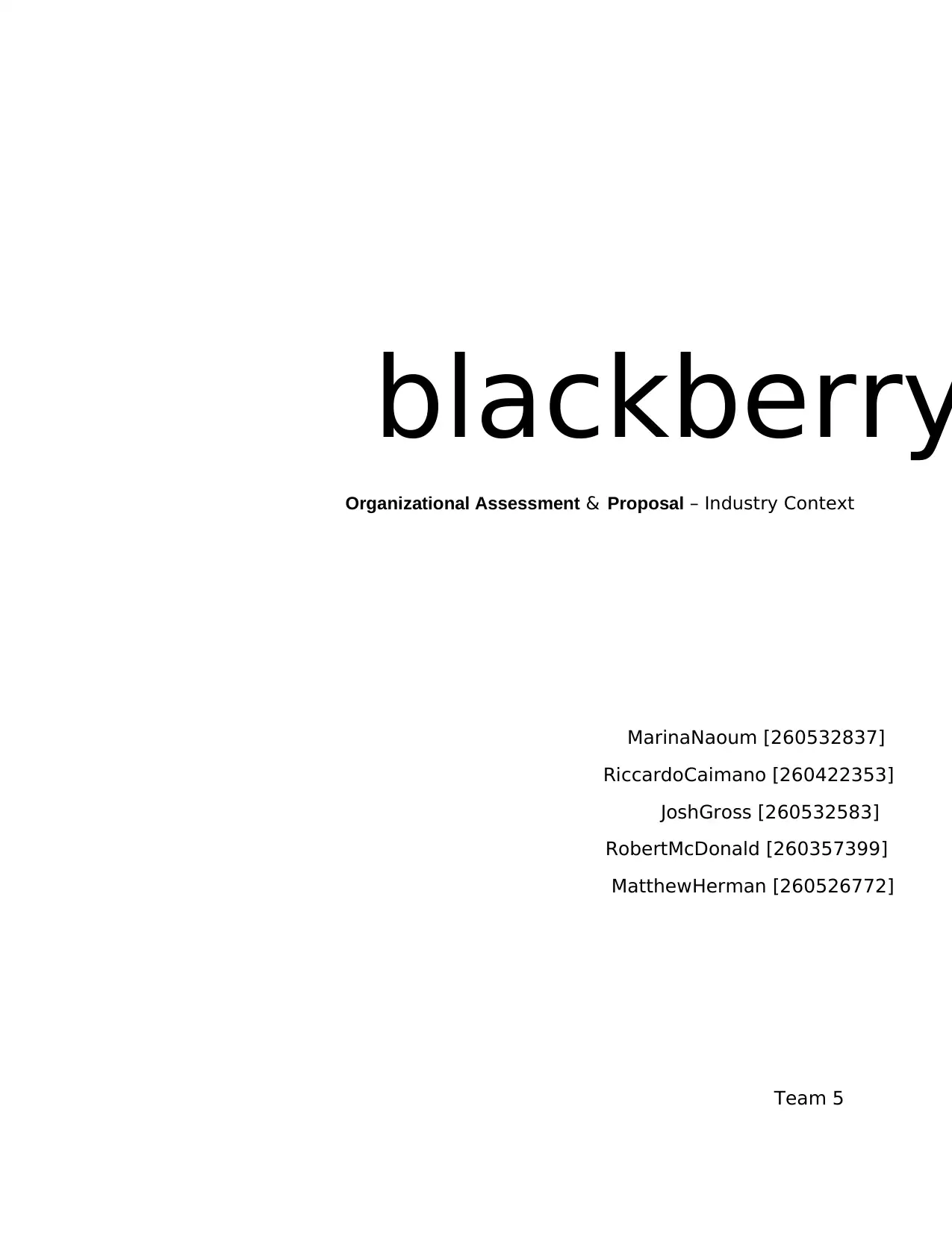
blackberry
Organizational Assessment & Proposal – Industry Context
MarinaNaoum [260532837]
RiccardoCaimano [260422353]
JoshGross [260532583]
RobertMcDonald [260357399]
MatthewHerman [260526772]
Team 5
Organizational Assessment & Proposal – Industry Context
MarinaNaoum [260532837]
RiccardoCaimano [260422353]
JoshGross [260532583]
RobertMcDonald [260357399]
MatthewHerman [260526772]
Team 5
Secure Best Marks with AI Grader
Need help grading? Try our AI Grader for instant feedback on your assignments.
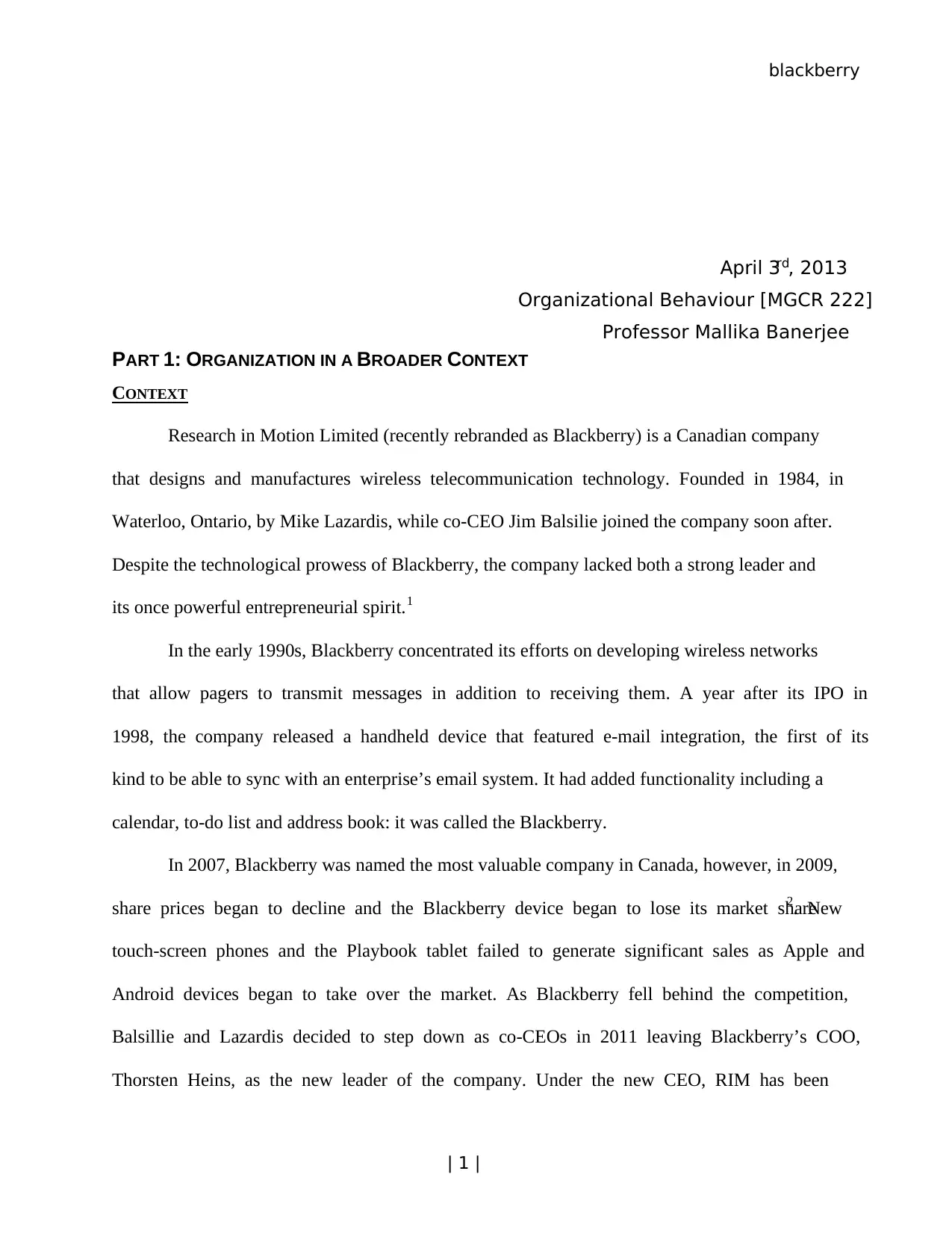
blackberry
| 1 |
April 3rd, 2013
Organizational Behaviour [MGCR 222]
Professor Mallika Banerjee
PART 1: ORGANIZATION IN A BROADER CONTEXT
CONTEXT
Research in Motion Limited (recently rebranded as Blackberry) is a Canadian company
that designs and manufactures wireless telecommunication technology. Founded in 1984, in
Waterloo, Ontario, by Mike Lazardis, while co-CEO Jim Balsilie joined the company soon after.
Despite the technological prowess of Blackberry, the company lacked both a strong leader and
its once powerful entrepreneurial spirit.1
In the early 1990s, Blackberry concentrated its efforts on developing wireless networks
that allow pagers to transmit messages in addition to receiving them. A year after its IPO in
1998, the company released a handheld device that featured e-mail integration, the first of its
kind to be able to sync with an enterprise’s email system. It had added functionality including a
calendar, to-do list and address book: it was called the Blackberry.
In 2007, Blackberry was named the most valuable company in Canada, however, in 2009,
share prices began to decline and the Blackberry device began to lose its market share2. New
touch-screen phones and the Playbook tablet failed to generate significant sales as Apple and
Android devices began to take over the market. As Blackberry fell behind the competition,
Balsillie and Lazardis decided to step down as co-CEOs in 2011 leaving Blackberry’s COO,
Thorsten Heins, as the new leader of the company. Under the new CEO, RIM has been
| 1 |
April 3rd, 2013
Organizational Behaviour [MGCR 222]
Professor Mallika Banerjee
PART 1: ORGANIZATION IN A BROADER CONTEXT
CONTEXT
Research in Motion Limited (recently rebranded as Blackberry) is a Canadian company
that designs and manufactures wireless telecommunication technology. Founded in 1984, in
Waterloo, Ontario, by Mike Lazardis, while co-CEO Jim Balsilie joined the company soon after.
Despite the technological prowess of Blackberry, the company lacked both a strong leader and
its once powerful entrepreneurial spirit.1
In the early 1990s, Blackberry concentrated its efforts on developing wireless networks
that allow pagers to transmit messages in addition to receiving them. A year after its IPO in
1998, the company released a handheld device that featured e-mail integration, the first of its
kind to be able to sync with an enterprise’s email system. It had added functionality including a
calendar, to-do list and address book: it was called the Blackberry.
In 2007, Blackberry was named the most valuable company in Canada, however, in 2009,
share prices began to decline and the Blackberry device began to lose its market share2. New
touch-screen phones and the Playbook tablet failed to generate significant sales as Apple and
Android devices began to take over the market. As Blackberry fell behind the competition,
Balsillie and Lazardis decided to step down as co-CEOs in 2011 leaving Blackberry’s COO,
Thorsten Heins, as the new leader of the company. Under the new CEO, RIM has been
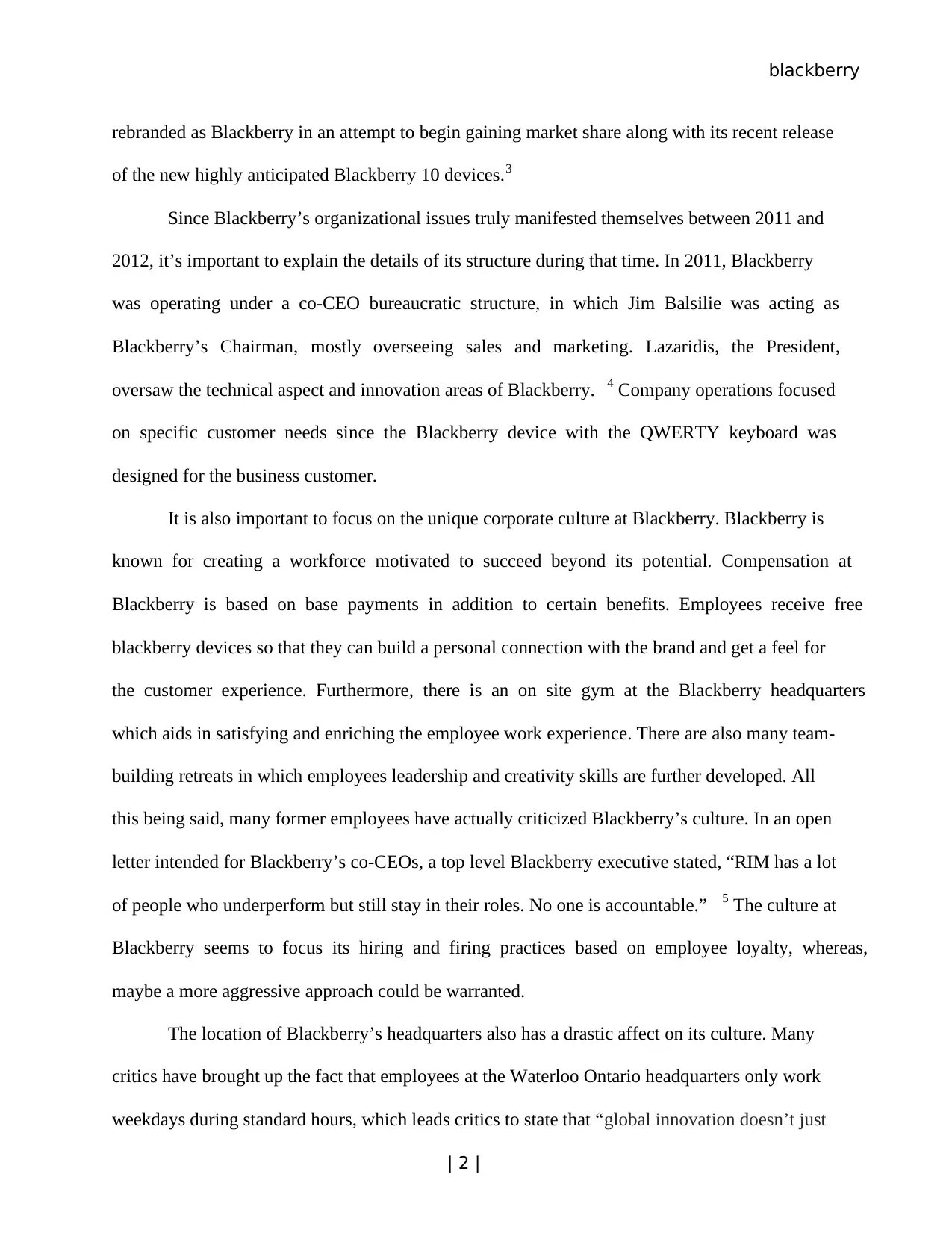
blackberry
| 2 |
rebranded as Blackberry in an attempt to begin gaining market share along with its recent release
of the new highly anticipated Blackberry 10 devices.3
Since Blackberry’s organizational issues truly manifested themselves between 2011 and
2012, it’s important to explain the details of its structure during that time. In 2011, Blackberry
was operating under a co-CEO bureaucratic structure, in which Jim Balsilie was acting as
Blackberry’s Chairman, mostly overseeing sales and marketing. Lazaridis, the President,
oversaw the technical aspect and innovation areas of Blackberry. 4 Company operations focused
on specific customer needs since the Blackberry device with the QWERTY keyboard was
designed for the business customer.
It is also important to focus on the unique corporate culture at Blackberry. Blackberry is
known for creating a workforce motivated to succeed beyond its potential. Compensation at
Blackberry is based on base payments in addition to certain benefits. Employees receive free
blackberry devices so that they can build a personal connection with the brand and get a feel for
the customer experience. Furthermore, there is an on site gym at the Blackberry headquarters
which aids in satisfying and enriching the employee work experience. There are also many team-
building retreats in which employees leadership and creativity skills are further developed. All
this being said, many former employees have actually criticized Blackberry’s culture. In an open
letter intended for Blackberry’s co-CEOs, a top level Blackberry executive stated, “RIM has a lot
of people who underperform but still stay in their roles. No one is accountable.” 5 The culture at
Blackberry seems to focus its hiring and firing practices based on employee loyalty, whereas,
maybe a more aggressive approach could be warranted.
The location of Blackberry’s headquarters also has a drastic affect on its culture. Many
critics have brought up the fact that employees at the Waterloo Ontario headquarters only work
weekdays during standard hours, which leads critics to state that “global innovation doesn’t just
| 2 |
rebranded as Blackberry in an attempt to begin gaining market share along with its recent release
of the new highly anticipated Blackberry 10 devices.3
Since Blackberry’s organizational issues truly manifested themselves between 2011 and
2012, it’s important to explain the details of its structure during that time. In 2011, Blackberry
was operating under a co-CEO bureaucratic structure, in which Jim Balsilie was acting as
Blackberry’s Chairman, mostly overseeing sales and marketing. Lazaridis, the President,
oversaw the technical aspect and innovation areas of Blackberry. 4 Company operations focused
on specific customer needs since the Blackberry device with the QWERTY keyboard was
designed for the business customer.
It is also important to focus on the unique corporate culture at Blackberry. Blackberry is
known for creating a workforce motivated to succeed beyond its potential. Compensation at
Blackberry is based on base payments in addition to certain benefits. Employees receive free
blackberry devices so that they can build a personal connection with the brand and get a feel for
the customer experience. Furthermore, there is an on site gym at the Blackberry headquarters
which aids in satisfying and enriching the employee work experience. There are also many team-
building retreats in which employees leadership and creativity skills are further developed. All
this being said, many former employees have actually criticized Blackberry’s culture. In an open
letter intended for Blackberry’s co-CEOs, a top level Blackberry executive stated, “RIM has a lot
of people who underperform but still stay in their roles. No one is accountable.” 5 The culture at
Blackberry seems to focus its hiring and firing practices based on employee loyalty, whereas,
maybe a more aggressive approach could be warranted.
The location of Blackberry’s headquarters also has a drastic affect on its culture. Many
critics have brought up the fact that employees at the Waterloo Ontario headquarters only work
weekdays during standard hours, which leads critics to state that “global innovation doesn’t just
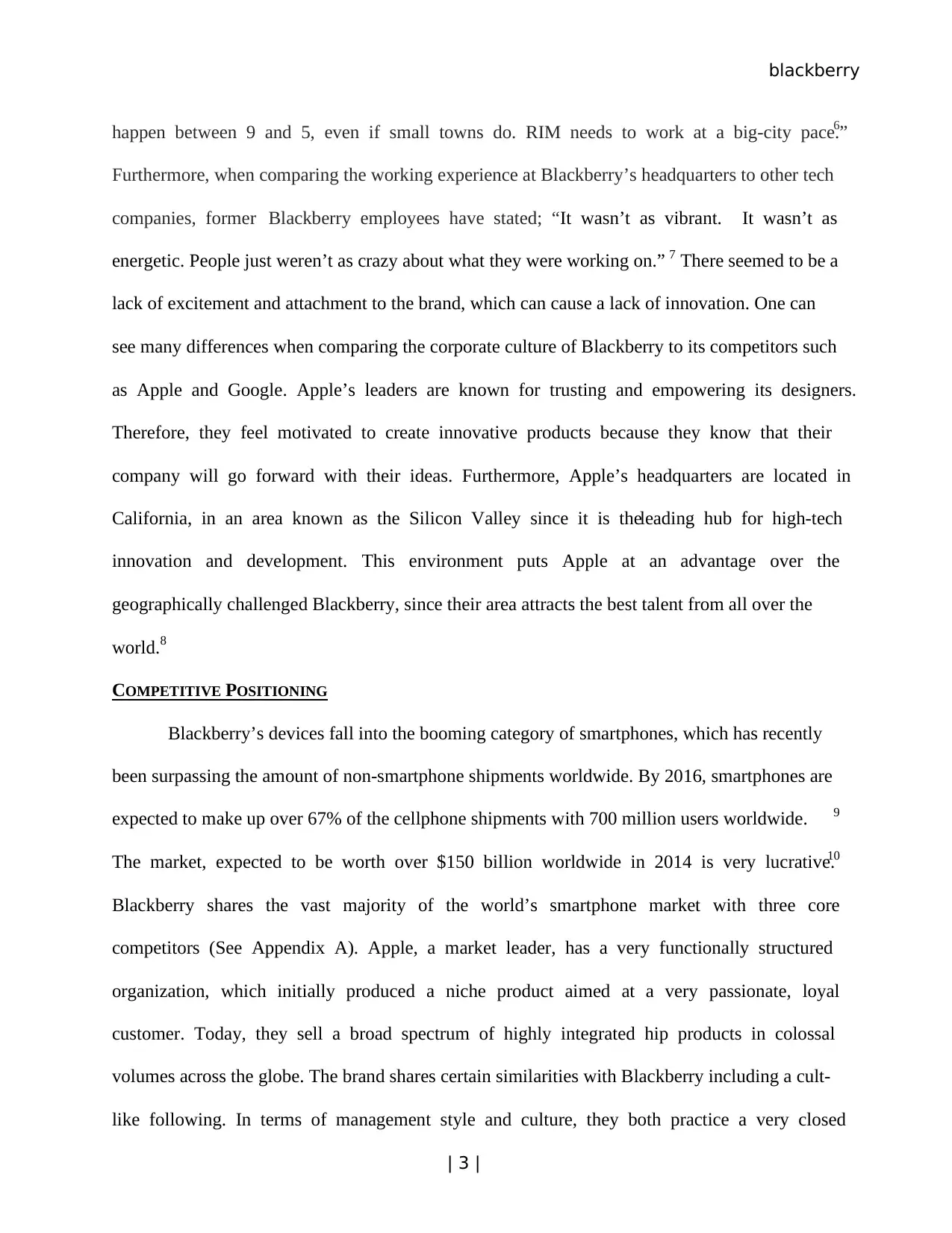
blackberry
| 3 |
happen between 9 and 5, even if small towns do. RIM needs to work at a big-city pace.”6
Furthermore, when comparing the working experience at Blackberry’s headquarters to other tech
companies, former Blackberry employees have stated; “It wasn’t as vibrant. It wasn’t as
energetic. People just weren’t as crazy about what they were working on.” 7 There seemed to be a
lack of excitement and attachment to the brand, which can cause a lack of innovation. One can
see many differences when comparing the corporate culture of Blackberry to its competitors such
as Apple and Google. Apple’s leaders are known for trusting and empowering its designers.
Therefore, they feel motivated to create innovative products because they know that their
company will go forward with their ideas. Furthermore, Apple’s headquarters are located in
California, in an area known as the Silicon Valley since it is theleading hub for high-tech
innovation and development. This environment puts Apple at an advantage over the
geographically challenged Blackberry, since their area attracts the best talent from all over the
world.8
COMPETITIVE POSITIONING
Blackberry’s devices fall into the booming category of smartphones, which has recently
been surpassing the amount of non-smartphone shipments worldwide. By 2016, smartphones are
expected to make up over 67% of the cellphone shipments with 700 million users worldwide. 9
The market, expected to be worth over $150 billion worldwide in 2014 is very lucrative.10
Blackberry shares the vast majority of the world’s smartphone market with three core
competitors (See Appendix A). Apple, a market leader, has a very functionally structured
organization, which initially produced a niche product aimed at a very passionate, loyal
customer. Today, they sell a broad spectrum of highly integrated hip products in colossal
volumes across the globe. The brand shares certain similarities with Blackberry including a cult-
like following. In terms of management style and culture, they both practice a very closed
| 3 |
happen between 9 and 5, even if small towns do. RIM needs to work at a big-city pace.”6
Furthermore, when comparing the working experience at Blackberry’s headquarters to other tech
companies, former Blackberry employees have stated; “It wasn’t as vibrant. It wasn’t as
energetic. People just weren’t as crazy about what they were working on.” 7 There seemed to be a
lack of excitement and attachment to the brand, which can cause a lack of innovation. One can
see many differences when comparing the corporate culture of Blackberry to its competitors such
as Apple and Google. Apple’s leaders are known for trusting and empowering its designers.
Therefore, they feel motivated to create innovative products because they know that their
company will go forward with their ideas. Furthermore, Apple’s headquarters are located in
California, in an area known as the Silicon Valley since it is theleading hub for high-tech
innovation and development. This environment puts Apple at an advantage over the
geographically challenged Blackberry, since their area attracts the best talent from all over the
world.8
COMPETITIVE POSITIONING
Blackberry’s devices fall into the booming category of smartphones, which has recently
been surpassing the amount of non-smartphone shipments worldwide. By 2016, smartphones are
expected to make up over 67% of the cellphone shipments with 700 million users worldwide. 9
The market, expected to be worth over $150 billion worldwide in 2014 is very lucrative.10
Blackberry shares the vast majority of the world’s smartphone market with three core
competitors (See Appendix A). Apple, a market leader, has a very functionally structured
organization, which initially produced a niche product aimed at a very passionate, loyal
customer. Today, they sell a broad spectrum of highly integrated hip products in colossal
volumes across the globe. The brand shares certain similarities with Blackberry including a cult-
like following. In terms of management style and culture, they both practice a very closed
Secure Best Marks with AI Grader
Need help grading? Try our AI Grader for instant feedback on your assignments.
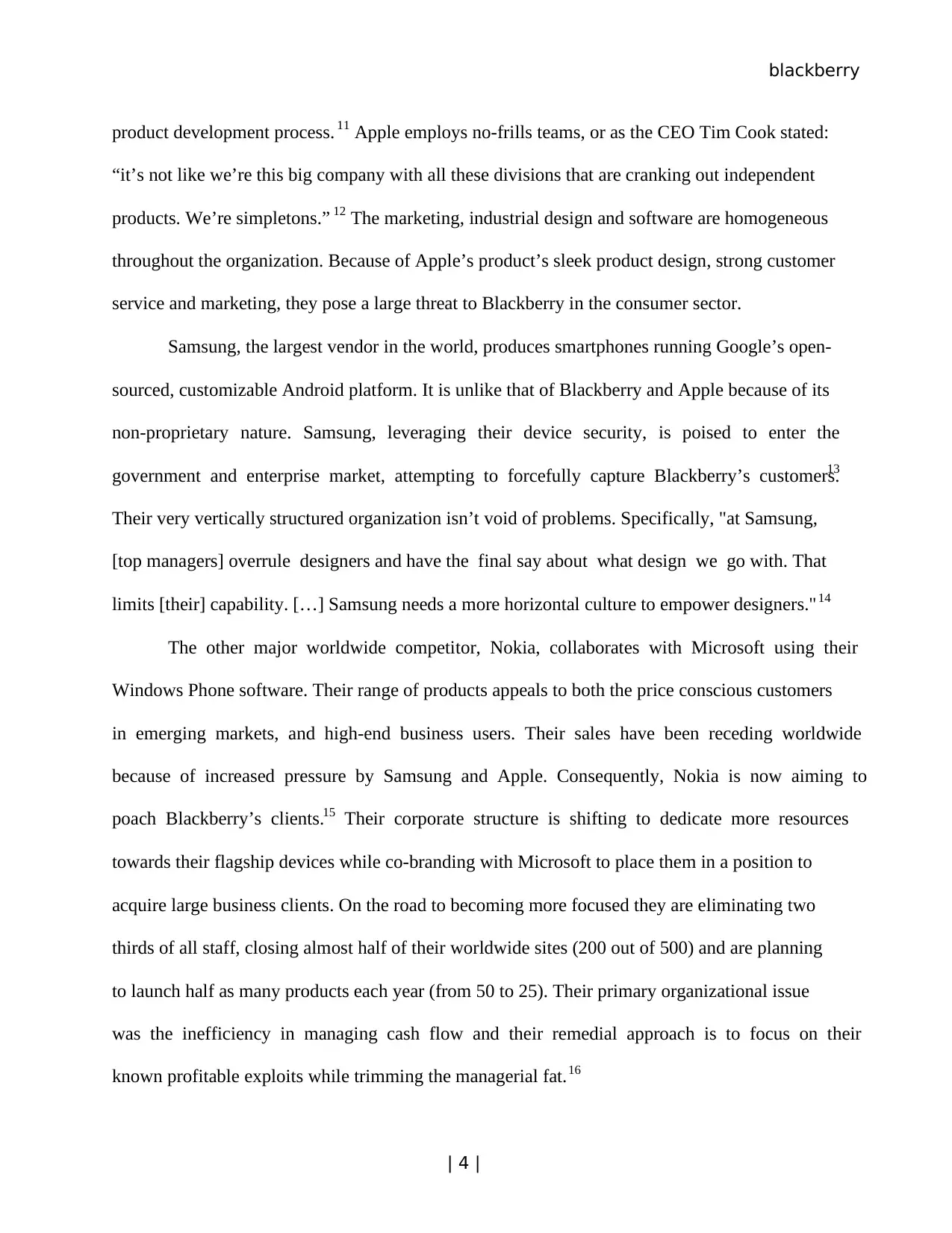
blackberry
| 4 |
product development process. 11 Apple employs no-frills teams, or as the CEO Tim Cook stated:
“it’s not like we’re this big company with all these divisions that are cranking out independent
products. We’re simpletons.” 12 The marketing, industrial design and software are homogeneous
throughout the organization. Because of Apple’s product’s sleek product design, strong customer
service and marketing, they pose a large threat to Blackberry in the consumer sector.
Samsung, the largest vendor in the world, produces smartphones running Google’s open-
sourced, customizable Android platform. It is unlike that of Blackberry and Apple because of its
non-proprietary nature. Samsung, leveraging their device security, is poised to enter the
government and enterprise market, attempting to forcefully capture Blackberry’s customers.13
Their very vertically structured organization isn’t void of problems. Specifically, "at Samsung,
[top managers] overrule designers and have the final say about what design we go with. That
limits [their] capability. […] Samsung needs a more horizontal culture to empower designers."14
The other major worldwide competitor, Nokia, collaborates with Microsoft using their
Windows Phone software. Their range of products appeals to both the price conscious customers
in emerging markets, and high-end business users. Their sales have been receding worldwide
because of increased pressure by Samsung and Apple. Consequently, Nokia is now aiming to
poach Blackberry’s clients.15 Their corporate structure is shifting to dedicate more resources
towards their flagship devices while co-branding with Microsoft to place them in a position to
acquire large business clients. On the road to becoming more focused they are eliminating two
thirds of all staff, closing almost half of their worldwide sites (200 out of 500) and are planning
to launch half as many products each year (from 50 to 25). Their primary organizational issue
was the inefficiency in managing cash flow and their remedial approach is to focus on their
known profitable exploits while trimming the managerial fat.16
| 4 |
product development process. 11 Apple employs no-frills teams, or as the CEO Tim Cook stated:
“it’s not like we’re this big company with all these divisions that are cranking out independent
products. We’re simpletons.” 12 The marketing, industrial design and software are homogeneous
throughout the organization. Because of Apple’s product’s sleek product design, strong customer
service and marketing, they pose a large threat to Blackberry in the consumer sector.
Samsung, the largest vendor in the world, produces smartphones running Google’s open-
sourced, customizable Android platform. It is unlike that of Blackberry and Apple because of its
non-proprietary nature. Samsung, leveraging their device security, is poised to enter the
government and enterprise market, attempting to forcefully capture Blackberry’s customers.13
Their very vertically structured organization isn’t void of problems. Specifically, "at Samsung,
[top managers] overrule designers and have the final say about what design we go with. That
limits [their] capability. […] Samsung needs a more horizontal culture to empower designers."14
The other major worldwide competitor, Nokia, collaborates with Microsoft using their
Windows Phone software. Their range of products appeals to both the price conscious customers
in emerging markets, and high-end business users. Their sales have been receding worldwide
because of increased pressure by Samsung and Apple. Consequently, Nokia is now aiming to
poach Blackberry’s clients.15 Their corporate structure is shifting to dedicate more resources
towards their flagship devices while co-branding with Microsoft to place them in a position to
acquire large business clients. On the road to becoming more focused they are eliminating two
thirds of all staff, closing almost half of their worldwide sites (200 out of 500) and are planning
to launch half as many products each year (from 50 to 25). Their primary organizational issue
was the inefficiency in managing cash flow and their remedial approach is to focus on their
known profitable exploits while trimming the managerial fat.16
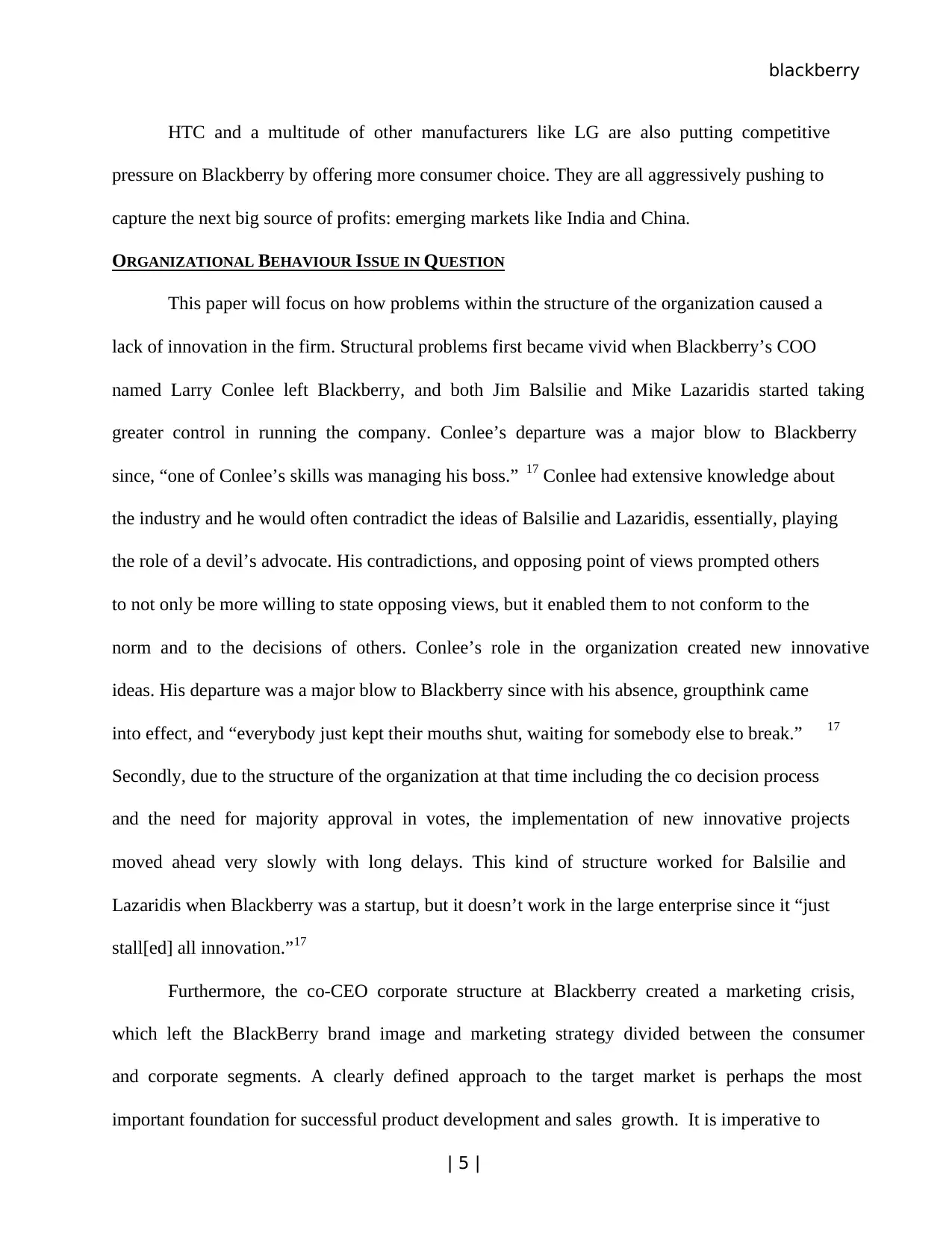
blackberry
| 5 |
HTC and a multitude of other manufacturers like LG are also putting competitive
pressure on Blackberry by offering more consumer choice. They are all aggressively pushing to
capture the next big source of profits: emerging markets like India and China.
ORGANIZATIONAL BEHAVIOUR ISSUE IN QUESTION
This paper will focus on how problems within the structure of the organization caused a
lack of innovation in the firm. Structural problems first became vivid when Blackberry’s COO
named Larry Conlee left Blackberry, and both Jim Balsilie and Mike Lazaridis started taking
greater control in running the company. Conlee’s departure was a major blow to Blackberry
since, “one of Conlee’s skills was managing his boss.” 17 Conlee had extensive knowledge about
the industry and he would often contradict the ideas of Balsilie and Lazaridis, essentially, playing
the role of a devil’s advocate. His contradictions, and opposing point of views prompted others
to not only be more willing to state opposing views, but it enabled them to not conform to the
norm and to the decisions of others. Conlee’s role in the organization created new innovative
ideas. His departure was a major blow to Blackberry since with his absence, groupthink came
into effect, and “everybody just kept their mouths shut, waiting for somebody else to break.” 17
Secondly, due to the structure of the organization at that time including the co decision process
and the need for majority approval in votes, the implementation of new innovative projects
moved ahead very slowly with long delays. This kind of structure worked for Balsilie and
Lazaridis when Blackberry was a startup, but it doesn’t work in the large enterprise since it “just
stall[ed] all innovation.”17
Furthermore, the co-CEO corporate structure at Blackberry created a marketing crisis,
which left the BlackBerry brand image and marketing strategy divided between the consumer
and corporate segments. A clearly defined approach to the target market is perhaps the most
important foundation for successful product development and sales growth. It is imperative to
| 5 |
HTC and a multitude of other manufacturers like LG are also putting competitive
pressure on Blackberry by offering more consumer choice. They are all aggressively pushing to
capture the next big source of profits: emerging markets like India and China.
ORGANIZATIONAL BEHAVIOUR ISSUE IN QUESTION
This paper will focus on how problems within the structure of the organization caused a
lack of innovation in the firm. Structural problems first became vivid when Blackberry’s COO
named Larry Conlee left Blackberry, and both Jim Balsilie and Mike Lazaridis started taking
greater control in running the company. Conlee’s departure was a major blow to Blackberry
since, “one of Conlee’s skills was managing his boss.” 17 Conlee had extensive knowledge about
the industry and he would often contradict the ideas of Balsilie and Lazaridis, essentially, playing
the role of a devil’s advocate. His contradictions, and opposing point of views prompted others
to not only be more willing to state opposing views, but it enabled them to not conform to the
norm and to the decisions of others. Conlee’s role in the organization created new innovative
ideas. His departure was a major blow to Blackberry since with his absence, groupthink came
into effect, and “everybody just kept their mouths shut, waiting for somebody else to break.” 17
Secondly, due to the structure of the organization at that time including the co decision process
and the need for majority approval in votes, the implementation of new innovative projects
moved ahead very slowly with long delays. This kind of structure worked for Balsilie and
Lazaridis when Blackberry was a startup, but it doesn’t work in the large enterprise since it “just
stall[ed] all innovation.”17
Furthermore, the co-CEO corporate structure at Blackberry created a marketing crisis,
which left the BlackBerry brand image and marketing strategy divided between the consumer
and corporate segments. A clearly defined approach to the target market is perhaps the most
important foundation for successful product development and sales growth. It is imperative to
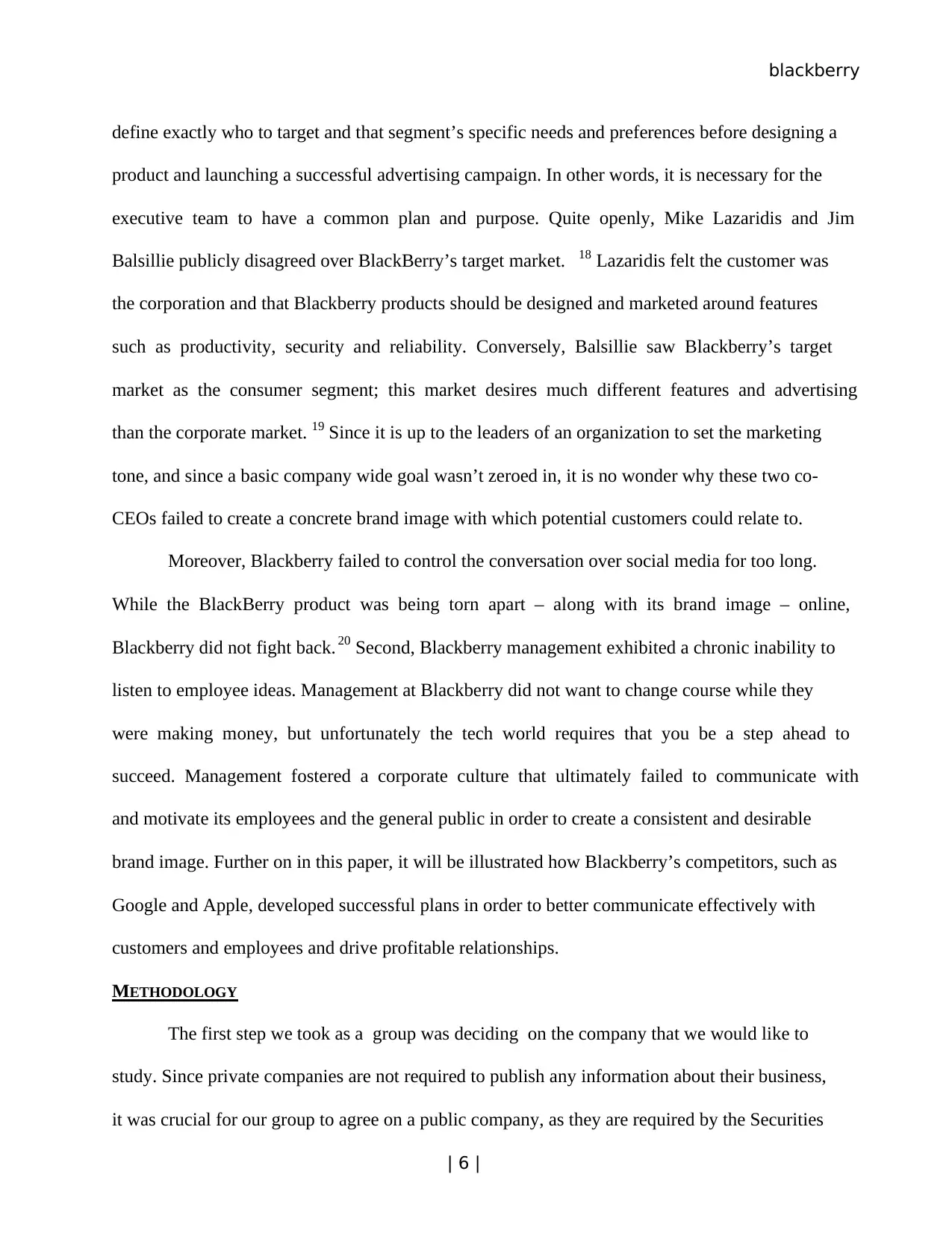
blackberry
| 6 |
define exactly who to target and that segment’s specific needs and preferences before designing a
product and launching a successful advertising campaign. In other words, it is necessary for the
executive team to have a common plan and purpose. Quite openly, Mike Lazaridis and Jim
Balsillie publicly disagreed over BlackBerry’s target market. 18 Lazaridis felt the customer was
the corporation and that Blackberry products should be designed and marketed around features
such as productivity, security and reliability. Conversely, Balsillie saw Blackberry’s target
market as the consumer segment; this market desires much different features and advertising
than the corporate market. 19 Since it is up to the leaders of an organization to set the marketing
tone, and since a basic company wide goal wasn’t zeroed in, it is no wonder why these two co-
CEOs failed to create a concrete brand image with which potential customers could relate to.
Moreover, Blackberry failed to control the conversation over social media for too long.
While the BlackBerry product was being torn apart – along with its brand image – online,
Blackberry did not fight back. 20 Second, Blackberry management exhibited a chronic inability to
listen to employee ideas. Management at Blackberry did not want to change course while they
were making money, but unfortunately the tech world requires that you be a step ahead to
succeed. Management fostered a corporate culture that ultimately failed to communicate with
and motivate its employees and the general public in order to create a consistent and desirable
brand image. Further on in this paper, it will be illustrated how Blackberry’s competitors, such as
Google and Apple, developed successful plans in order to better communicate effectively with
customers and employees and drive profitable relationships.
METHODOLOGY
The first step we took as a group was deciding on the company that we would like to
study. Since private companies are not required to publish any information about their business,
it was crucial for our group to agree on a public company, as they are required by the Securities
| 6 |
define exactly who to target and that segment’s specific needs and preferences before designing a
product and launching a successful advertising campaign. In other words, it is necessary for the
executive team to have a common plan and purpose. Quite openly, Mike Lazaridis and Jim
Balsillie publicly disagreed over BlackBerry’s target market. 18 Lazaridis felt the customer was
the corporation and that Blackberry products should be designed and marketed around features
such as productivity, security and reliability. Conversely, Balsillie saw Blackberry’s target
market as the consumer segment; this market desires much different features and advertising
than the corporate market. 19 Since it is up to the leaders of an organization to set the marketing
tone, and since a basic company wide goal wasn’t zeroed in, it is no wonder why these two co-
CEOs failed to create a concrete brand image with which potential customers could relate to.
Moreover, Blackberry failed to control the conversation over social media for too long.
While the BlackBerry product was being torn apart – along with its brand image – online,
Blackberry did not fight back. 20 Second, Blackberry management exhibited a chronic inability to
listen to employee ideas. Management at Blackberry did not want to change course while they
were making money, but unfortunately the tech world requires that you be a step ahead to
succeed. Management fostered a corporate culture that ultimately failed to communicate with
and motivate its employees and the general public in order to create a consistent and desirable
brand image. Further on in this paper, it will be illustrated how Blackberry’s competitors, such as
Google and Apple, developed successful plans in order to better communicate effectively with
customers and employees and drive profitable relationships.
METHODOLOGY
The first step we took as a group was deciding on the company that we would like to
study. Since private companies are not required to publish any information about their business,
it was crucial for our group to agree on a public company, as they are required by the Securities
Paraphrase This Document
Need a fresh take? Get an instant paraphrase of this document with our AI Paraphraser
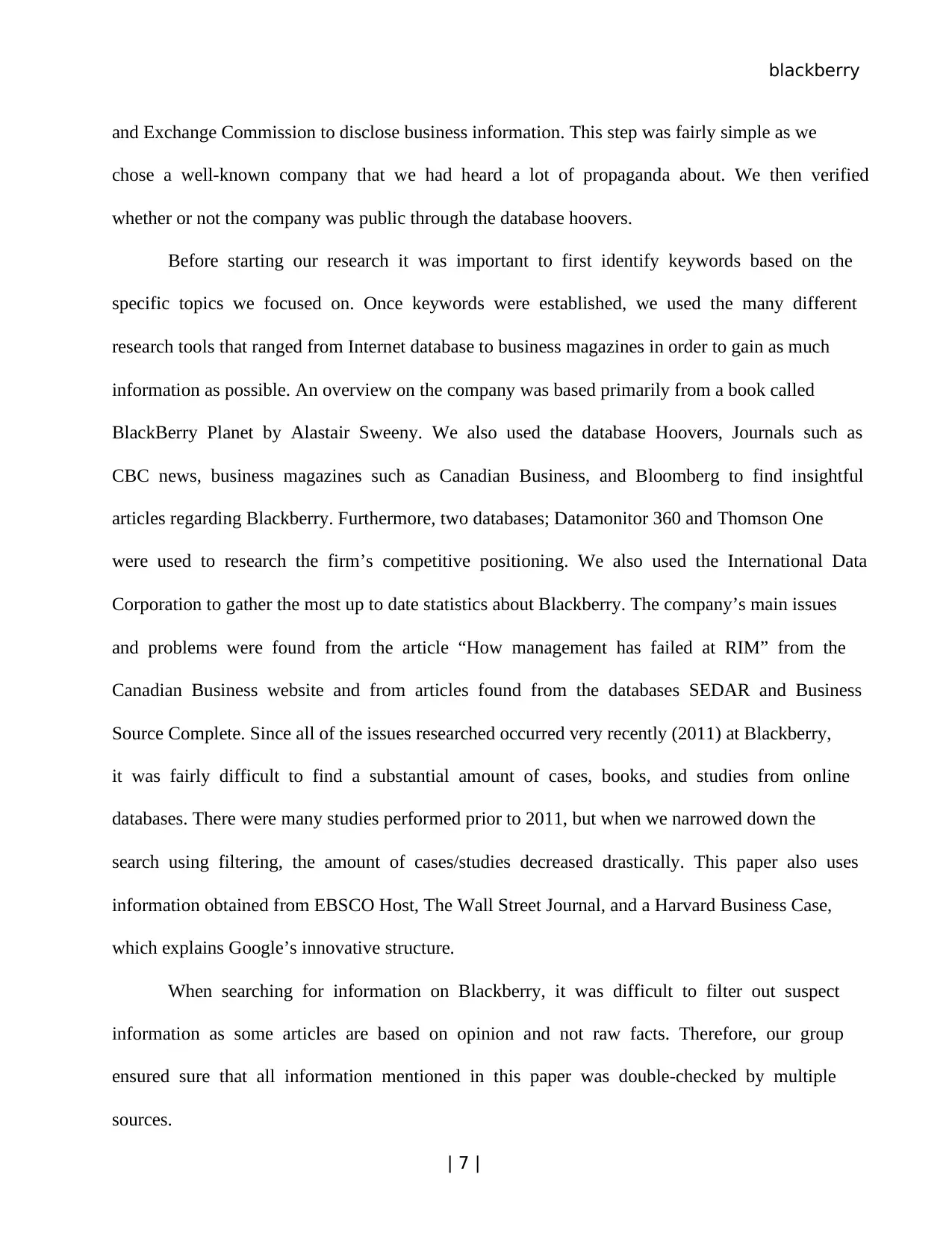
blackberry
| 7 |
and Exchange Commission to disclose business information. This step was fairly simple as we
chose a well-known company that we had heard a lot of propaganda about. We then verified
whether or not the company was public through the database hoovers.
Before starting our research it was important to first identify keywords based on the
specific topics we focused on. Once keywords were established, we used the many different
research tools that ranged from Internet database to business magazines in order to gain as much
information as possible. An overview on the company was based primarily from a book called
BlackBerry Planet by Alastair Sweeny. We also used the database Hoovers, Journals such as
CBC news, business magazines such as Canadian Business, and Bloomberg to find insightful
articles regarding Blackberry. Furthermore, two databases; Datamonitor 360 and Thomson One
were used to research the firm’s competitive positioning. We also used the International Data
Corporation to gather the most up to date statistics about Blackberry. The company’s main issues
and problems were found from the article “How management has failed at RIM” from the
Canadian Business website and from articles found from the databases SEDAR and Business
Source Complete. Since all of the issues researched occurred very recently (2011) at Blackberry,
it was fairly difficult to find a substantial amount of cases, books, and studies from online
databases. There were many studies performed prior to 2011, but when we narrowed down the
search using filtering, the amount of cases/studies decreased drastically. This paper also uses
information obtained from EBSCO Host, The Wall Street Journal, and a Harvard Business Case,
which explains Google’s innovative structure.
When searching for information on Blackberry, it was difficult to filter out suspect
information as some articles are based on opinion and not raw facts. Therefore, our group
ensured sure that all information mentioned in this paper was double-checked by multiple
sources.
| 7 |
and Exchange Commission to disclose business information. This step was fairly simple as we
chose a well-known company that we had heard a lot of propaganda about. We then verified
whether or not the company was public through the database hoovers.
Before starting our research it was important to first identify keywords based on the
specific topics we focused on. Once keywords were established, we used the many different
research tools that ranged from Internet database to business magazines in order to gain as much
information as possible. An overview on the company was based primarily from a book called
BlackBerry Planet by Alastair Sweeny. We also used the database Hoovers, Journals such as
CBC news, business magazines such as Canadian Business, and Bloomberg to find insightful
articles regarding Blackberry. Furthermore, two databases; Datamonitor 360 and Thomson One
were used to research the firm’s competitive positioning. We also used the International Data
Corporation to gather the most up to date statistics about Blackberry. The company’s main issues
and problems were found from the article “How management has failed at RIM” from the
Canadian Business website and from articles found from the databases SEDAR and Business
Source Complete. Since all of the issues researched occurred very recently (2011) at Blackberry,
it was fairly difficult to find a substantial amount of cases, books, and studies from online
databases. There were many studies performed prior to 2011, but when we narrowed down the
search using filtering, the amount of cases/studies decreased drastically. This paper also uses
information obtained from EBSCO Host, The Wall Street Journal, and a Harvard Business Case,
which explains Google’s innovative structure.
When searching for information on Blackberry, it was difficult to filter out suspect
information as some articles are based on opinion and not raw facts. Therefore, our group
ensured sure that all information mentioned in this paper was double-checked by multiple
sources.
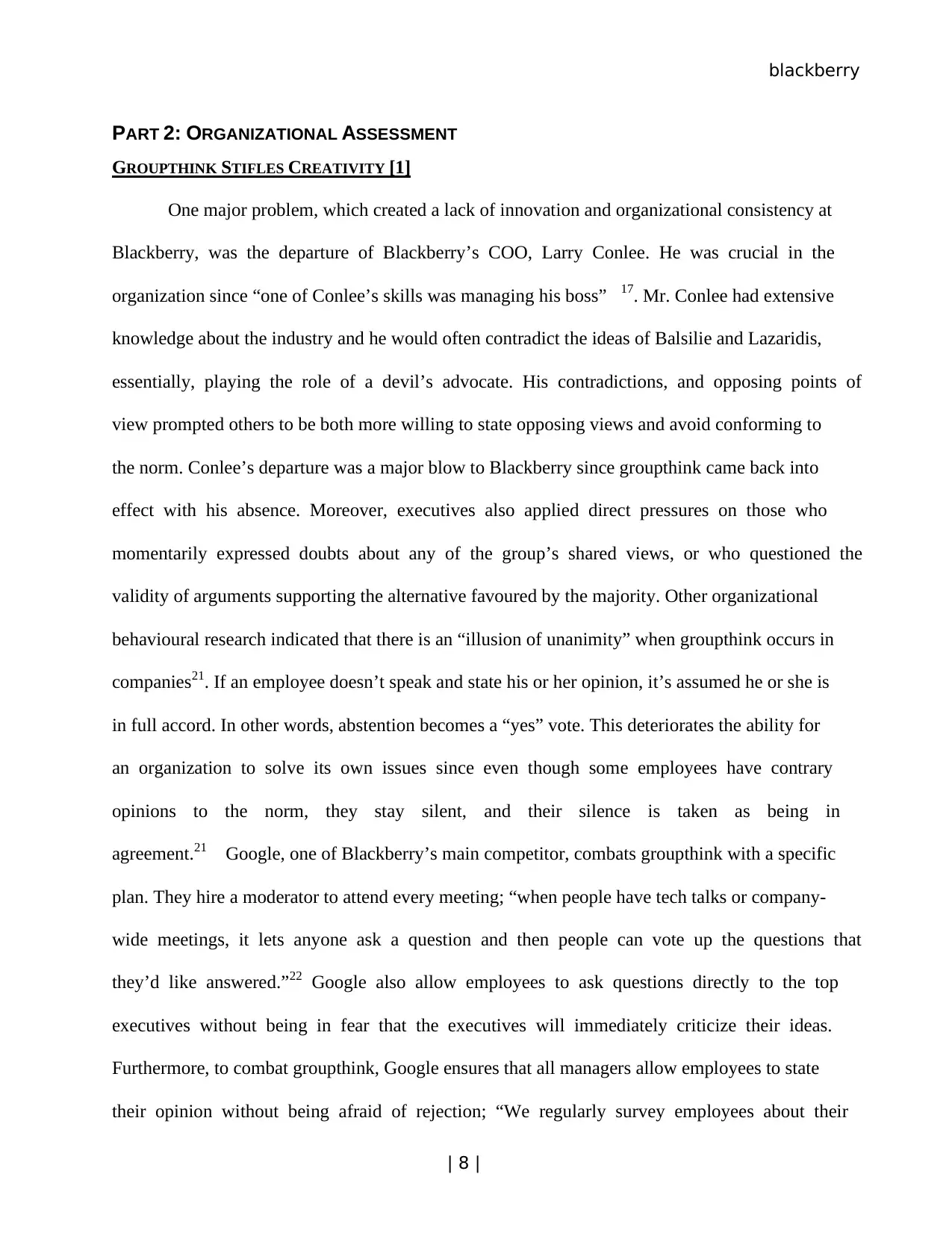
blackberry
| 8 |
PART 2: ORGANIZATIONAL ASSESSMENT
GROUPTHINK STIFLES CREATIVITY [1]
One major problem, which created a lack of innovation and organizational consistency at
Blackberry, was the departure of Blackberry’s COO, Larry Conlee. He was crucial in the
organization since “one of Conlee’s skills was managing his boss” 17. Mr. Conlee had extensive
knowledge about the industry and he would often contradict the ideas of Balsilie and Lazaridis,
essentially, playing the role of a devil’s advocate. His contradictions, and opposing points of
view prompted others to be both more willing to state opposing views and avoid conforming to
the norm. Conlee’s departure was a major blow to Blackberry since groupthink came back into
effect with his absence. Moreover, executives also applied direct pressures on those who
momentarily expressed doubts about any of the group’s shared views, or who questioned the
validity of arguments supporting the alternative favoured by the majority. Other organizational
behavioural research indicated that there is an “illusion of unanimity” when groupthink occurs in
companies21. If an employee doesn’t speak and state his or her opinion, it’s assumed he or she is
in full accord. In other words, abstention becomes a “yes” vote. This deteriorates the ability for
an organization to solve its own issues since even though some employees have contrary
opinions to the norm, they stay silent, and their silence is taken as being in
agreement.21 Google, one of Blackberry’s main competitor, combats groupthink with a specific
plan. They hire a moderator to attend every meeting; “when people have tech talks or company-
wide meetings, it lets anyone ask a question and then people can vote up the questions that
they’d like answered.”22 Google also allow employees to ask questions directly to the top
executives without being in fear that the executives will immediately criticize their ideas.
Furthermore, to combat groupthink, Google ensures that all managers allow employees to state
their opinion without being afraid of rejection; “We regularly survey employees about their
| 8 |
PART 2: ORGANIZATIONAL ASSESSMENT
GROUPTHINK STIFLES CREATIVITY [1]
One major problem, which created a lack of innovation and organizational consistency at
Blackberry, was the departure of Blackberry’s COO, Larry Conlee. He was crucial in the
organization since “one of Conlee’s skills was managing his boss” 17. Mr. Conlee had extensive
knowledge about the industry and he would often contradict the ideas of Balsilie and Lazaridis,
essentially, playing the role of a devil’s advocate. His contradictions, and opposing points of
view prompted others to be both more willing to state opposing views and avoid conforming to
the norm. Conlee’s departure was a major blow to Blackberry since groupthink came back into
effect with his absence. Moreover, executives also applied direct pressures on those who
momentarily expressed doubts about any of the group’s shared views, or who questioned the
validity of arguments supporting the alternative favoured by the majority. Other organizational
behavioural research indicated that there is an “illusion of unanimity” when groupthink occurs in
companies21. If an employee doesn’t speak and state his or her opinion, it’s assumed he or she is
in full accord. In other words, abstention becomes a “yes” vote. This deteriorates the ability for
an organization to solve its own issues since even though some employees have contrary
opinions to the norm, they stay silent, and their silence is taken as being in
agreement.21 Google, one of Blackberry’s main competitor, combats groupthink with a specific
plan. They hire a moderator to attend every meeting; “when people have tech talks or company-
wide meetings, it lets anyone ask a question and then people can vote up the questions that
they’d like answered.”22 Google also allow employees to ask questions directly to the top
executives without being in fear that the executives will immediately criticize their ideas.
Furthermore, to combat groupthink, Google ensures that all managers allow employees to state
their opinion without being afraid of rejection; “We regularly survey employees about their
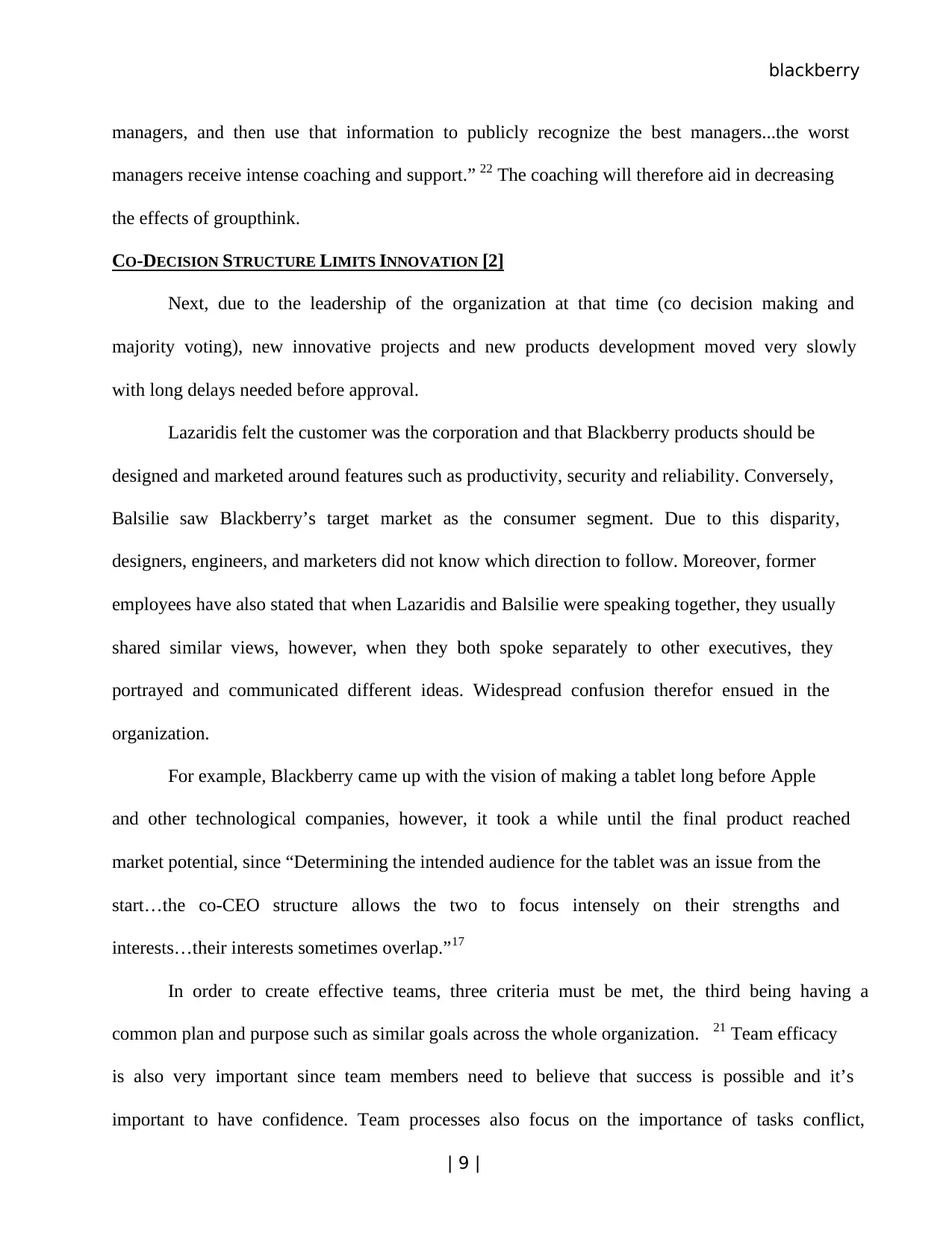
blackberry
| 9 |
managers, and then use that information to publicly recognize the best managers...the worst
managers receive intense coaching and support.” 22 The coaching will therefore aid in decreasing
the effects of groupthink.
CO-DECISION STRUCTURE LIMITS INNOVATION [2]
Next, due to the leadership of the organization at that time (co decision making and
majority voting), new innovative projects and new products development moved very slowly
with long delays needed before approval.
Lazaridis felt the customer was the corporation and that Blackberry products should be
designed and marketed around features such as productivity, security and reliability. Conversely,
Balsilie saw Blackberry’s target market as the consumer segment. Due to this disparity,
designers, engineers, and marketers did not know which direction to follow. Moreover, former
employees have also stated that when Lazaridis and Balsilie were speaking together, they usually
shared similar views, however, when they both spoke separately to other executives, they
portrayed and communicated different ideas. Widespread confusion therefor ensued in the
organization.
For example, Blackberry came up with the vision of making a tablet long before Apple
and other technological companies, however, it took a while until the final product reached
market potential, since “Determining the intended audience for the tablet was an issue from the
start…the co-CEO structure allows the two to focus intensely on their strengths and
interests…their interests sometimes overlap.”17
In order to create effective teams, three criteria must be met, the third being having a
common plan and purpose such as similar goals across the whole organization. 21 Team efficacy
is also very important since team members need to believe that success is possible and it’s
important to have confidence. Team processes also focus on the importance of tasks conflict,
| 9 |
managers, and then use that information to publicly recognize the best managers...the worst
managers receive intense coaching and support.” 22 The coaching will therefore aid in decreasing
the effects of groupthink.
CO-DECISION STRUCTURE LIMITS INNOVATION [2]
Next, due to the leadership of the organization at that time (co decision making and
majority voting), new innovative projects and new products development moved very slowly
with long delays needed before approval.
Lazaridis felt the customer was the corporation and that Blackberry products should be
designed and marketed around features such as productivity, security and reliability. Conversely,
Balsilie saw Blackberry’s target market as the consumer segment. Due to this disparity,
designers, engineers, and marketers did not know which direction to follow. Moreover, former
employees have also stated that when Lazaridis and Balsilie were speaking together, they usually
shared similar views, however, when they both spoke separately to other executives, they
portrayed and communicated different ideas. Widespread confusion therefor ensued in the
organization.
For example, Blackberry came up with the vision of making a tablet long before Apple
and other technological companies, however, it took a while until the final product reached
market potential, since “Determining the intended audience for the tablet was an issue from the
start…the co-CEO structure allows the two to focus intensely on their strengths and
interests…their interests sometimes overlap.”17
In order to create effective teams, three criteria must be met, the third being having a
common plan and purpose such as similar goals across the whole organization. 21 Team efficacy
is also very important since team members need to believe that success is possible and it’s
important to have confidence. Team processes also focus on the importance of tasks conflict,
Secure Best Marks with AI Grader
Need help grading? Try our AI Grader for instant feedback on your assignments.
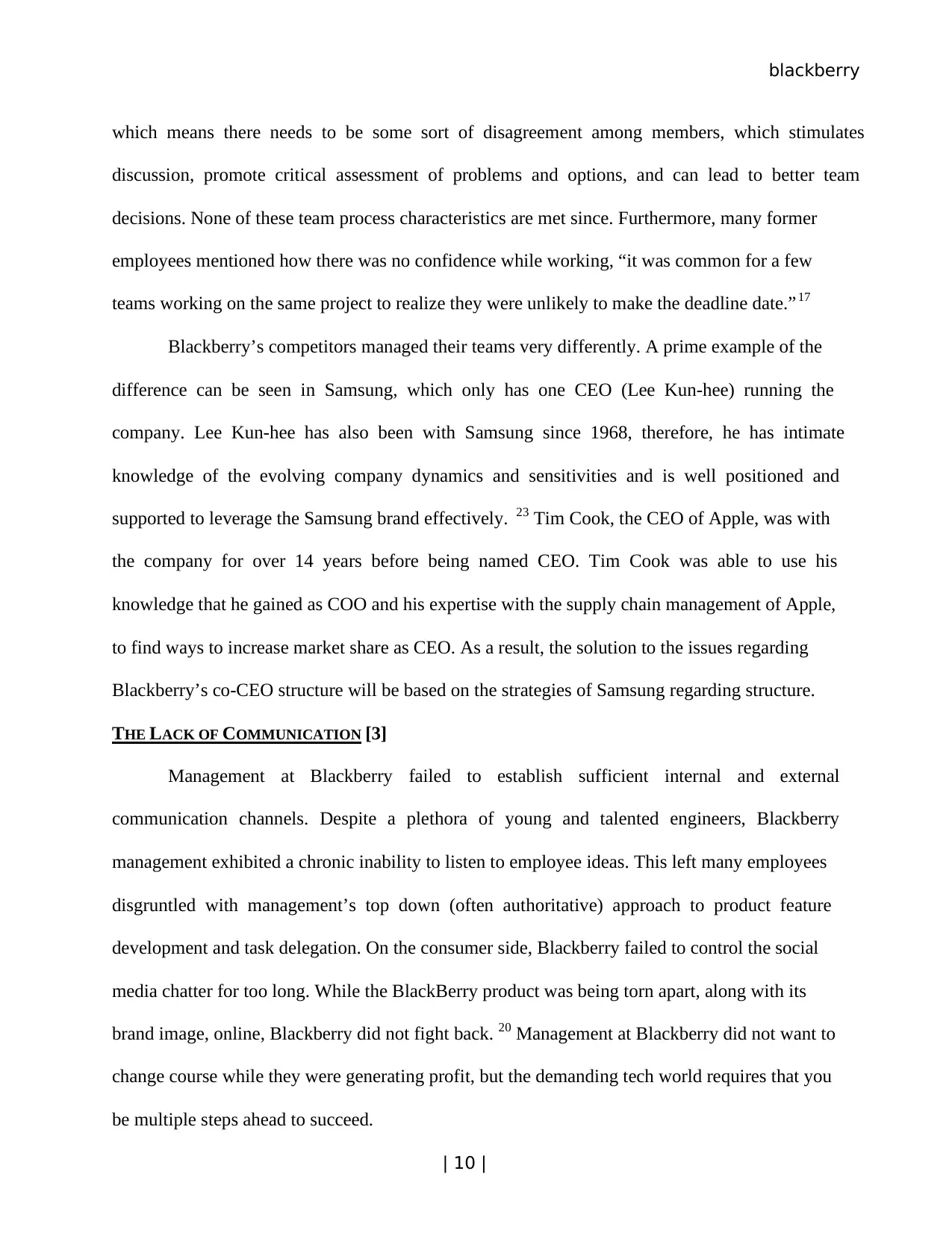
blackberry
| 10 |
which means there needs to be some sort of disagreement among members, which stimulates
discussion, promote critical assessment of problems and options, and can lead to better team
decisions. None of these team process characteristics are met since. Furthermore, many former
employees mentioned how there was no confidence while working, “it was common for a few
teams working on the same project to realize they were unlikely to make the deadline date.”17
Blackberry’s competitors managed their teams very differently. A prime example of the
difference can be seen in Samsung, which only has one CEO (Lee Kun-hee) running the
company. Lee Kun-hee has also been with Samsung since 1968, therefore, he has intimate
knowledge of the evolving company dynamics and sensitivities and is well positioned and
supported to leverage the Samsung brand effectively. 23 Tim Cook, the CEO of Apple, was with
the company for over 14 years before being named CEO. Tim Cook was able to use his
knowledge that he gained as COO and his expertise with the supply chain management of Apple,
to find ways to increase market share as CEO. As a result, the solution to the issues regarding
Blackberry’s co-CEO structure will be based on the strategies of Samsung regarding structure.
THE LACK OF COMMUNICATION [3]
Management at Blackberry failed to establish sufficient internal and external
communication channels. Despite a plethora of young and talented engineers, Blackberry
management exhibited a chronic inability to listen to employee ideas. This left many employees
disgruntled with management’s top down (often authoritative) approach to product feature
development and task delegation. On the consumer side, Blackberry failed to control the social
media chatter for too long. While the BlackBerry product was being torn apart, along with its
brand image, online, Blackberry did not fight back. 20 Management at Blackberry did not want to
change course while they were generating profit, but the demanding tech world requires that you
be multiple steps ahead to succeed.
| 10 |
which means there needs to be some sort of disagreement among members, which stimulates
discussion, promote critical assessment of problems and options, and can lead to better team
decisions. None of these team process characteristics are met since. Furthermore, many former
employees mentioned how there was no confidence while working, “it was common for a few
teams working on the same project to realize they were unlikely to make the deadline date.”17
Blackberry’s competitors managed their teams very differently. A prime example of the
difference can be seen in Samsung, which only has one CEO (Lee Kun-hee) running the
company. Lee Kun-hee has also been with Samsung since 1968, therefore, he has intimate
knowledge of the evolving company dynamics and sensitivities and is well positioned and
supported to leverage the Samsung brand effectively. 23 Tim Cook, the CEO of Apple, was with
the company for over 14 years before being named CEO. Tim Cook was able to use his
knowledge that he gained as COO and his expertise with the supply chain management of Apple,
to find ways to increase market share as CEO. As a result, the solution to the issues regarding
Blackberry’s co-CEO structure will be based on the strategies of Samsung regarding structure.
THE LACK OF COMMUNICATION [3]
Management at Blackberry failed to establish sufficient internal and external
communication channels. Despite a plethora of young and talented engineers, Blackberry
management exhibited a chronic inability to listen to employee ideas. This left many employees
disgruntled with management’s top down (often authoritative) approach to product feature
development and task delegation. On the consumer side, Blackberry failed to control the social
media chatter for too long. While the BlackBerry product was being torn apart, along with its
brand image, online, Blackberry did not fight back. 20 Management at Blackberry did not want to
change course while they were generating profit, but the demanding tech world requires that you
be multiple steps ahead to succeed.
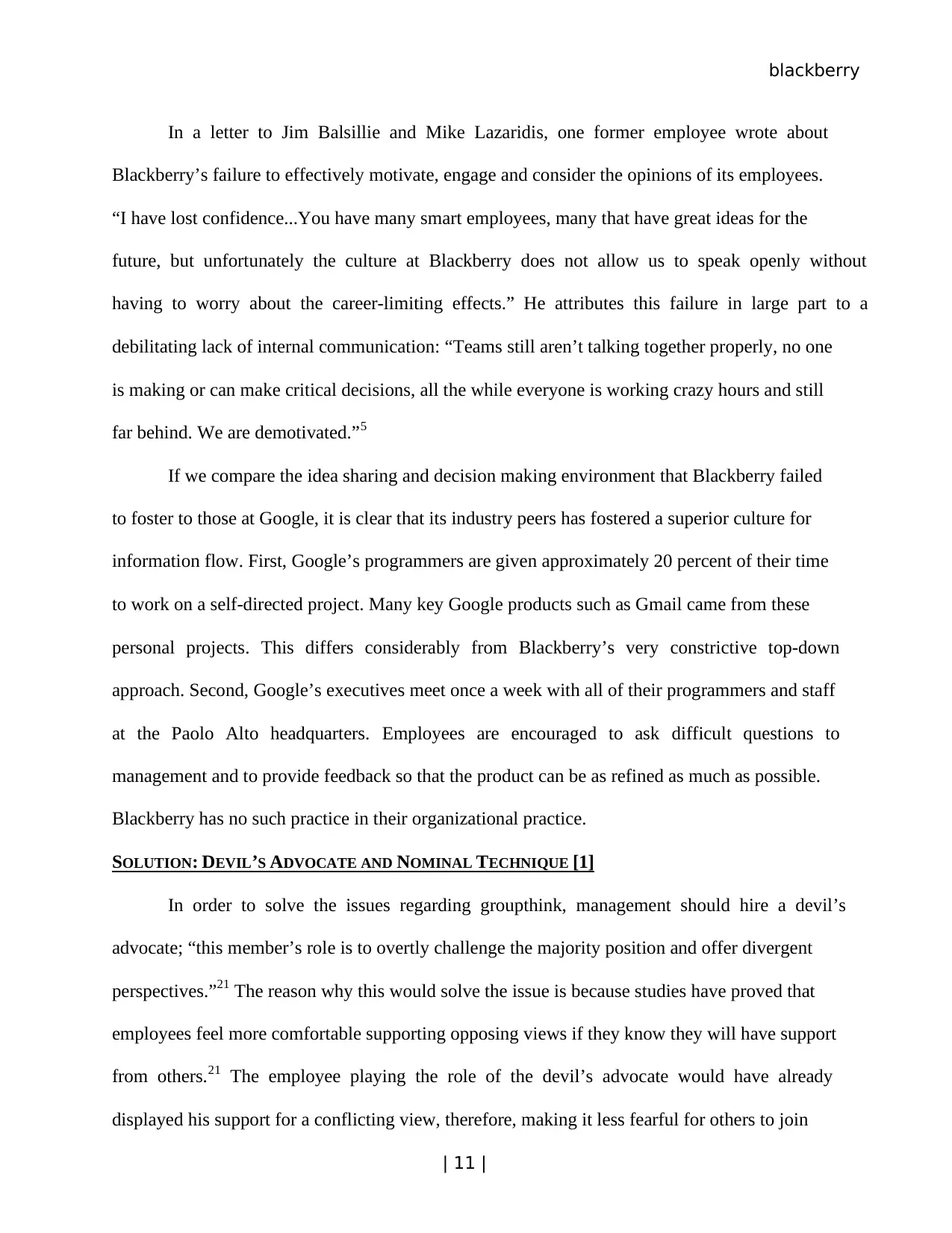
blackberry
| 11 |
In a letter to Jim Balsillie and Mike Lazaridis, one former employee wrote about
Blackberry’s failure to effectively motivate, engage and consider the opinions of its employees.
“I have lost confidence...You have many smart employees, many that have great ideas for the
future, but unfortunately the culture at Blackberry does not allow us to speak openly without
having to worry about the career-limiting effects.” He attributes this failure in large part to a
debilitating lack of internal communication: “Teams still aren’t talking together properly, no one
is making or can make critical decisions, all the while everyone is working crazy hours and still
far behind. We are demotivated.”5
If we compare the idea sharing and decision making environment that Blackberry failed
to foster to those at Google, it is clear that its industry peers has fostered a superior culture for
information flow. First, Google’s programmers are given approximately 20 percent of their time
to work on a self-directed project. Many key Google products such as Gmail came from these
personal projects. This differs considerably from Blackberry’s very constrictive top-down
approach. Second, Google’s executives meet once a week with all of their programmers and staff
at the Paolo Alto headquarters. Employees are encouraged to ask difficult questions to
management and to provide feedback so that the product can be as refined as much as possible.
Blackberry has no such practice in their organizational practice.
SOLUTION: DEVIL’S ADVOCATE AND NOMINAL TECHNIQUE [1]
In order to solve the issues regarding groupthink, management should hire a devil’s
advocate; “this member’s role is to overtly challenge the majority position and offer divergent
perspectives.”21 The reason why this would solve the issue is because studies have proved that
employees feel more comfortable supporting opposing views if they know they will have support
from others.21 The employee playing the role of the devil’s advocate would have already
displayed his support for a conflicting view, therefore, making it less fearful for others to join
| 11 |
In a letter to Jim Balsillie and Mike Lazaridis, one former employee wrote about
Blackberry’s failure to effectively motivate, engage and consider the opinions of its employees.
“I have lost confidence...You have many smart employees, many that have great ideas for the
future, but unfortunately the culture at Blackberry does not allow us to speak openly without
having to worry about the career-limiting effects.” He attributes this failure in large part to a
debilitating lack of internal communication: “Teams still aren’t talking together properly, no one
is making or can make critical decisions, all the while everyone is working crazy hours and still
far behind. We are demotivated.”5
If we compare the idea sharing and decision making environment that Blackberry failed
to foster to those at Google, it is clear that its industry peers has fostered a superior culture for
information flow. First, Google’s programmers are given approximately 20 percent of their time
to work on a self-directed project. Many key Google products such as Gmail came from these
personal projects. This differs considerably from Blackberry’s very constrictive top-down
approach. Second, Google’s executives meet once a week with all of their programmers and staff
at the Paolo Alto headquarters. Employees are encouraged to ask difficult questions to
management and to provide feedback so that the product can be as refined as much as possible.
Blackberry has no such practice in their organizational practice.
SOLUTION: DEVIL’S ADVOCATE AND NOMINAL TECHNIQUE [1]
In order to solve the issues regarding groupthink, management should hire a devil’s
advocate; “this member’s role is to overtly challenge the majority position and offer divergent
perspectives.”21 The reason why this would solve the issue is because studies have proved that
employees feel more comfortable supporting opposing views if they know they will have support
from others.21 The employee playing the role of the devil’s advocate would have already
displayed his support for a conflicting view, therefore, making it less fearful for others to join
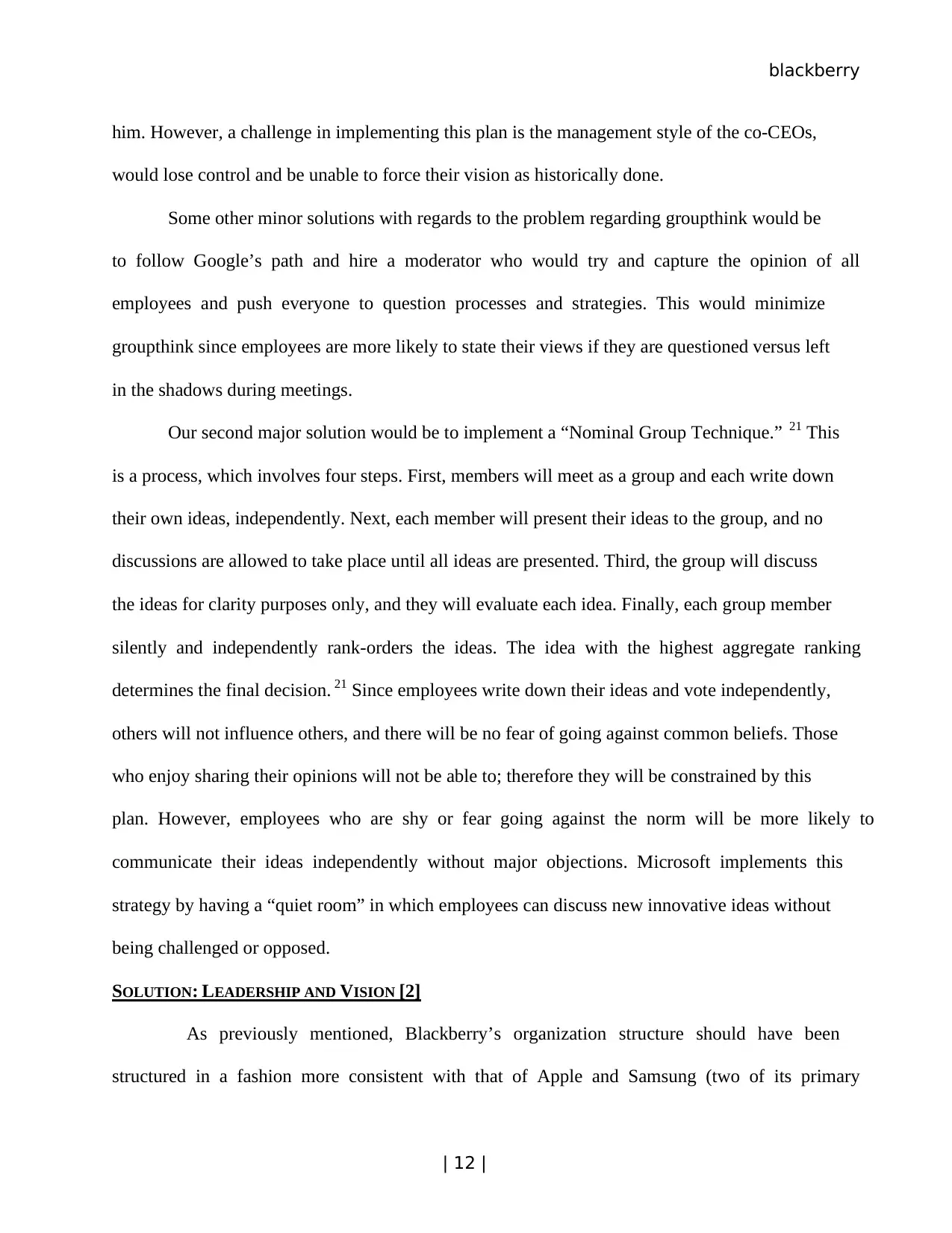
blackberry
| 12 |
him. However, a challenge in implementing this plan is the management style of the co-CEOs,
would lose control and be unable to force their vision as historically done.
Some other minor solutions with regards to the problem regarding groupthink would be
to follow Google’s path and hire a moderator who would try and capture the opinion of all
employees and push everyone to question processes and strategies. This would minimize
groupthink since employees are more likely to state their views if they are questioned versus left
in the shadows during meetings.
Our second major solution would be to implement a “Nominal Group Technique.” 21 This
is a process, which involves four steps. First, members will meet as a group and each write down
their own ideas, independently. Next, each member will present their ideas to the group, and no
discussions are allowed to take place until all ideas are presented. Third, the group will discuss
the ideas for clarity purposes only, and they will evaluate each idea. Finally, each group member
silently and independently rank-orders the ideas. The idea with the highest aggregate ranking
determines the final decision. 21 Since employees write down their ideas and vote independently,
others will not influence others, and there will be no fear of going against common beliefs. Those
who enjoy sharing their opinions will not be able to; therefore they will be constrained by this
plan. However, employees who are shy or fear going against the norm will be more likely to
communicate their ideas independently without major objections. Microsoft implements this
strategy by having a “quiet room” in which employees can discuss new innovative ideas without
being challenged or opposed.
SOLUTION: LEADERSHIP AND VISION [2]
As previously mentioned, Blackberry’s organization structure should have been
structured in a fashion more consistent with that of Apple and Samsung (two of its primary
| 12 |
him. However, a challenge in implementing this plan is the management style of the co-CEOs,
would lose control and be unable to force their vision as historically done.
Some other minor solutions with regards to the problem regarding groupthink would be
to follow Google’s path and hire a moderator who would try and capture the opinion of all
employees and push everyone to question processes and strategies. This would minimize
groupthink since employees are more likely to state their views if they are questioned versus left
in the shadows during meetings.
Our second major solution would be to implement a “Nominal Group Technique.” 21 This
is a process, which involves four steps. First, members will meet as a group and each write down
their own ideas, independently. Next, each member will present their ideas to the group, and no
discussions are allowed to take place until all ideas are presented. Third, the group will discuss
the ideas for clarity purposes only, and they will evaluate each idea. Finally, each group member
silently and independently rank-orders the ideas. The idea with the highest aggregate ranking
determines the final decision. 21 Since employees write down their ideas and vote independently,
others will not influence others, and there will be no fear of going against common beliefs. Those
who enjoy sharing their opinions will not be able to; therefore they will be constrained by this
plan. However, employees who are shy or fear going against the norm will be more likely to
communicate their ideas independently without major objections. Microsoft implements this
strategy by having a “quiet room” in which employees can discuss new innovative ideas without
being challenged or opposed.
SOLUTION: LEADERSHIP AND VISION [2]
As previously mentioned, Blackberry’s organization structure should have been
structured in a fashion more consistent with that of Apple and Samsung (two of its primary
Paraphrase This Document
Need a fresh take? Get an instant paraphrase of this document with our AI Paraphraser
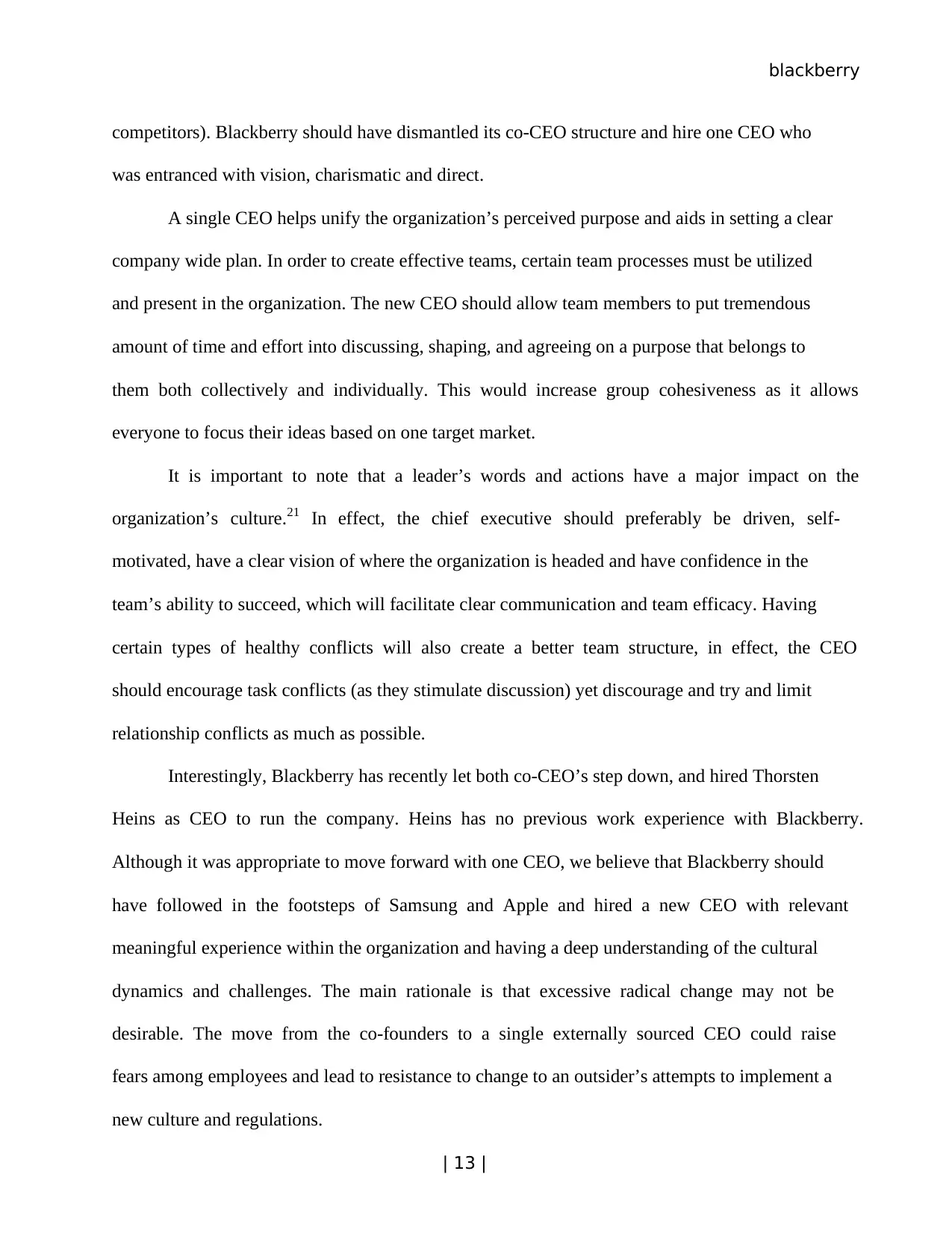
blackberry
| 13 |
competitors). Blackberry should have dismantled its co-CEO structure and hire one CEO who
was entranced with vision, charismatic and direct.
A single CEO helps unify the organization’s perceived purpose and aids in setting a clear
company wide plan. In order to create effective teams, certain team processes must be utilized
and present in the organization. The new CEO should allow team members to put tremendous
amount of time and effort into discussing, shaping, and agreeing on a purpose that belongs to
them both collectively and individually. This would increase group cohesiveness as it allows
everyone to focus their ideas based on one target market.
It is important to note that a leader’s words and actions have a major impact on the
organization’s culture.21 In effect, the chief executive should preferably be driven, self-
motivated, have a clear vision of where the organization is headed and have confidence in the
team’s ability to succeed, which will facilitate clear communication and team efficacy. Having
certain types of healthy conflicts will also create a better team structure, in effect, the CEO
should encourage task conflicts (as they stimulate discussion) yet discourage and try and limit
relationship conflicts as much as possible.
Interestingly, Blackberry has recently let both co-CEO’s step down, and hired Thorsten
Heins as CEO to run the company. Heins has no previous work experience with Blackberry.
Although it was appropriate to move forward with one CEO, we believe that Blackberry should
have followed in the footsteps of Samsung and Apple and hired a new CEO with relevant
meaningful experience within the organization and having a deep understanding of the cultural
dynamics and challenges. The main rationale is that excessive radical change may not be
desirable. The move from the co-founders to a single externally sourced CEO could raise
fears among employees and lead to resistance to change to an outsider’s attempts to implement a
new culture and regulations.
| 13 |
competitors). Blackberry should have dismantled its co-CEO structure and hire one CEO who
was entranced with vision, charismatic and direct.
A single CEO helps unify the organization’s perceived purpose and aids in setting a clear
company wide plan. In order to create effective teams, certain team processes must be utilized
and present in the organization. The new CEO should allow team members to put tremendous
amount of time and effort into discussing, shaping, and agreeing on a purpose that belongs to
them both collectively and individually. This would increase group cohesiveness as it allows
everyone to focus their ideas based on one target market.
It is important to note that a leader’s words and actions have a major impact on the
organization’s culture.21 In effect, the chief executive should preferably be driven, self-
motivated, have a clear vision of where the organization is headed and have confidence in the
team’s ability to succeed, which will facilitate clear communication and team efficacy. Having
certain types of healthy conflicts will also create a better team structure, in effect, the CEO
should encourage task conflicts (as they stimulate discussion) yet discourage and try and limit
relationship conflicts as much as possible.
Interestingly, Blackberry has recently let both co-CEO’s step down, and hired Thorsten
Heins as CEO to run the company. Heins has no previous work experience with Blackberry.
Although it was appropriate to move forward with one CEO, we believe that Blackberry should
have followed in the footsteps of Samsung and Apple and hired a new CEO with relevant
meaningful experience within the organization and having a deep understanding of the cultural
dynamics and challenges. The main rationale is that excessive radical change may not be
desirable. The move from the co-founders to a single externally sourced CEO could raise
fears among employees and lead to resistance to change to an outsider’s attempts to implement a
new culture and regulations.
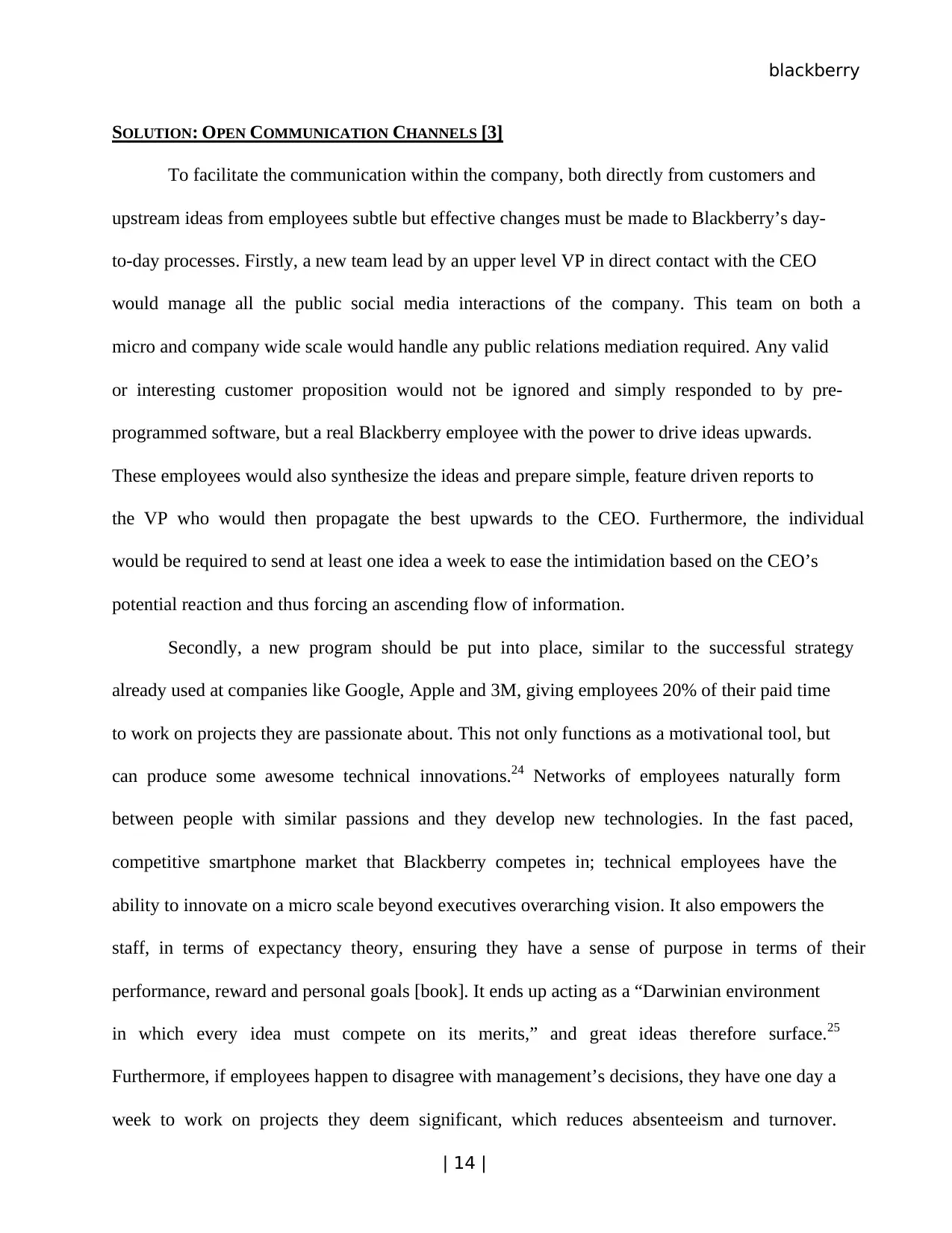
blackberry
| 14 |
SOLUTION: OPEN COMMUNICATION CHANNELS [3]
To facilitate the communication within the company, both directly from customers and
upstream ideas from employees subtle but effective changes must be made to Blackberry’s day-
to-day processes. Firstly, a new team lead by an upper level VP in direct contact with the CEO
would manage all the public social media interactions of the company. This team on both a
micro and company wide scale would handle any public relations mediation required. Any valid
or interesting customer proposition would not be ignored and simply responded to by pre-
programmed software, but a real Blackberry employee with the power to drive ideas upwards.
These employees would also synthesize the ideas and prepare simple, feature driven reports to
the VP who would then propagate the best upwards to the CEO. Furthermore, the individual
would be required to send at least one idea a week to ease the intimidation based on the CEO’s
potential reaction and thus forcing an ascending flow of information.
Secondly, a new program should be put into place, similar to the successful strategy
already used at companies like Google, Apple and 3M, giving employees 20% of their paid time
to work on projects they are passionate about. This not only functions as a motivational tool, but
can produce some awesome technical innovations.24 Networks of employees naturally form
between people with similar passions and they develop new technologies. In the fast paced,
competitive smartphone market that Blackberry competes in; technical employees have the
ability to innovate on a micro scale beyond executives overarching vision. It also empowers the
staff, in terms of expectancy theory, ensuring they have a sense of purpose in terms of their
performance, reward and personal goals [book]. It ends up acting as a “Darwinian environment
in which every idea must compete on its merits,” and great ideas therefore surface.25
Furthermore, if employees happen to disagree with management’s decisions, they have one day a
week to work on projects they deem significant, which reduces absenteeism and turnover.
| 14 |
SOLUTION: OPEN COMMUNICATION CHANNELS [3]
To facilitate the communication within the company, both directly from customers and
upstream ideas from employees subtle but effective changes must be made to Blackberry’s day-
to-day processes. Firstly, a new team lead by an upper level VP in direct contact with the CEO
would manage all the public social media interactions of the company. This team on both a
micro and company wide scale would handle any public relations mediation required. Any valid
or interesting customer proposition would not be ignored and simply responded to by pre-
programmed software, but a real Blackberry employee with the power to drive ideas upwards.
These employees would also synthesize the ideas and prepare simple, feature driven reports to
the VP who would then propagate the best upwards to the CEO. Furthermore, the individual
would be required to send at least one idea a week to ease the intimidation based on the CEO’s
potential reaction and thus forcing an ascending flow of information.
Secondly, a new program should be put into place, similar to the successful strategy
already used at companies like Google, Apple and 3M, giving employees 20% of their paid time
to work on projects they are passionate about. This not only functions as a motivational tool, but
can produce some awesome technical innovations.24 Networks of employees naturally form
between people with similar passions and they develop new technologies. In the fast paced,
competitive smartphone market that Blackberry competes in; technical employees have the
ability to innovate on a micro scale beyond executives overarching vision. It also empowers the
staff, in terms of expectancy theory, ensuring they have a sense of purpose in terms of their
performance, reward and personal goals [book]. It ends up acting as a “Darwinian environment
in which every idea must compete on its merits,” and great ideas therefore surface.25
Furthermore, if employees happen to disagree with management’s decisions, they have one day a
week to work on projects they deem significant, which reduces absenteeism and turnover.
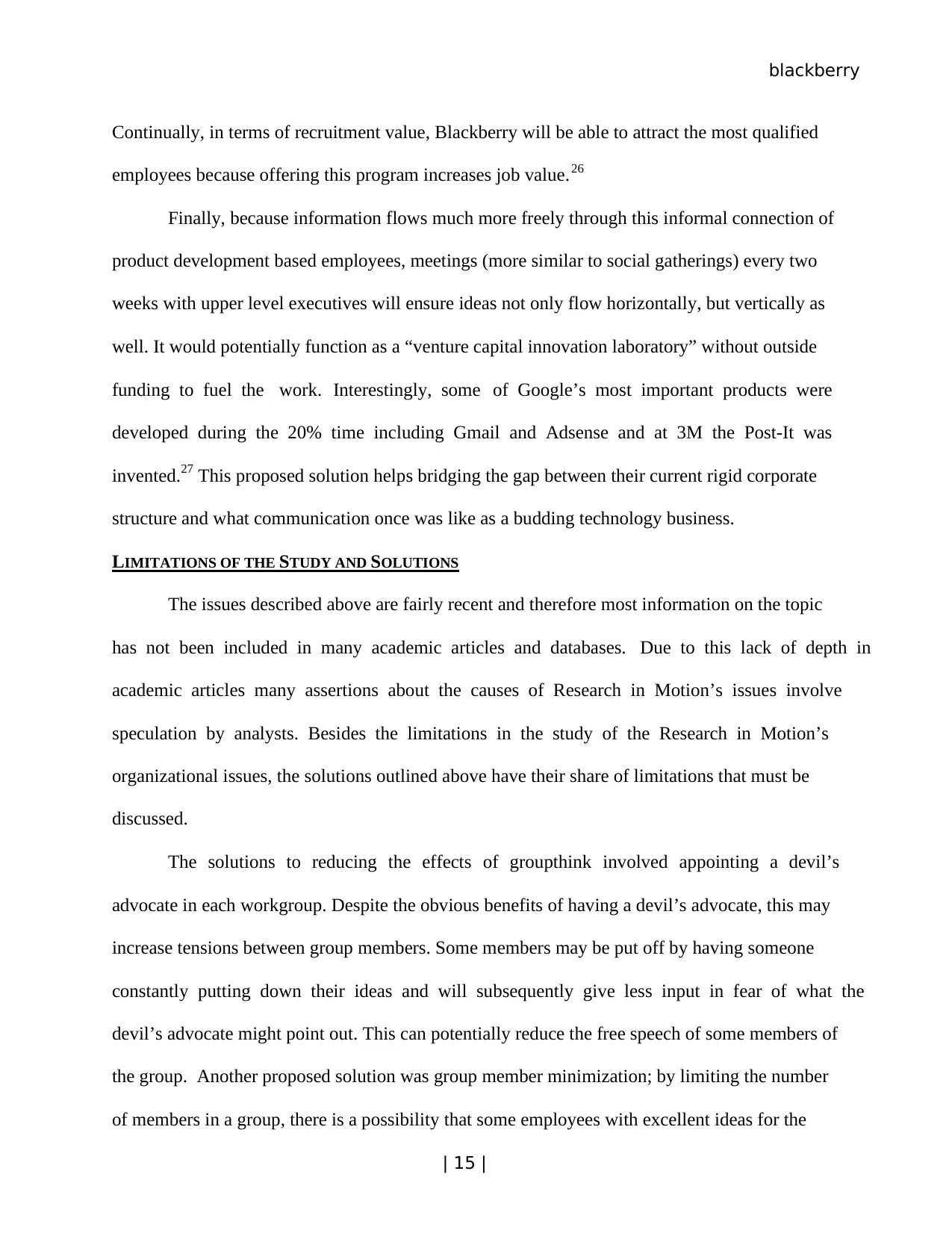
blackberry
| 15 |
Continually, in terms of recruitment value, Blackberry will be able to attract the most qualified
employees because offering this program increases job value.26
Finally, because information flows much more freely through this informal connection of
product development based employees, meetings (more similar to social gatherings) every two
weeks with upper level executives will ensure ideas not only flow horizontally, but vertically as
well. It would potentially function as a “venture capital innovation laboratory” without outside
funding to fuel the work. Interestingly, some of Google’s most important products were
developed during the 20% time including Gmail and Adsense and at 3M the Post-It was
invented.27 This proposed solution helps bridging the gap between their current rigid corporate
structure and what communication once was like as a budding technology business.
LIMITATIONS OF THE STUDY AND SOLUTIONS
The issues described above are fairly recent and therefore most information on the topic
has not been included in many academic articles and databases. Due to this lack of depth in
academic articles many assertions about the causes of Research in Motion’s issues involve
speculation by analysts. Besides the limitations in the study of the Research in Motion’s
organizational issues, the solutions outlined above have their share of limitations that must be
discussed.
The solutions to reducing the effects of groupthink involved appointing a devil’s
advocate in each workgroup. Despite the obvious benefits of having a devil’s advocate, this may
increase tensions between group members. Some members may be put off by having someone
constantly putting down their ideas and will subsequently give less input in fear of what the
devil’s advocate might point out. This can potentially reduce the free speech of some members of
the group. Another proposed solution was group member minimization; by limiting the number
of members in a group, there is a possibility that some employees with excellent ideas for the
| 15 |
Continually, in terms of recruitment value, Blackberry will be able to attract the most qualified
employees because offering this program increases job value.26
Finally, because information flows much more freely through this informal connection of
product development based employees, meetings (more similar to social gatherings) every two
weeks with upper level executives will ensure ideas not only flow horizontally, but vertically as
well. It would potentially function as a “venture capital innovation laboratory” without outside
funding to fuel the work. Interestingly, some of Google’s most important products were
developed during the 20% time including Gmail and Adsense and at 3M the Post-It was
invented.27 This proposed solution helps bridging the gap between their current rigid corporate
structure and what communication once was like as a budding technology business.
LIMITATIONS OF THE STUDY AND SOLUTIONS
The issues described above are fairly recent and therefore most information on the topic
has not been included in many academic articles and databases. Due to this lack of depth in
academic articles many assertions about the causes of Research in Motion’s issues involve
speculation by analysts. Besides the limitations in the study of the Research in Motion’s
organizational issues, the solutions outlined above have their share of limitations that must be
discussed.
The solutions to reducing the effects of groupthink involved appointing a devil’s
advocate in each workgroup. Despite the obvious benefits of having a devil’s advocate, this may
increase tensions between group members. Some members may be put off by having someone
constantly putting down their ideas and will subsequently give less input in fear of what the
devil’s advocate might point out. This can potentially reduce the free speech of some members of
the group. Another proposed solution was group member minimization; by limiting the number
of members in a group, there is a possibility that some employees with excellent ideas for the
Secure Best Marks with AI Grader
Need help grading? Try our AI Grader for instant feedback on your assignments.
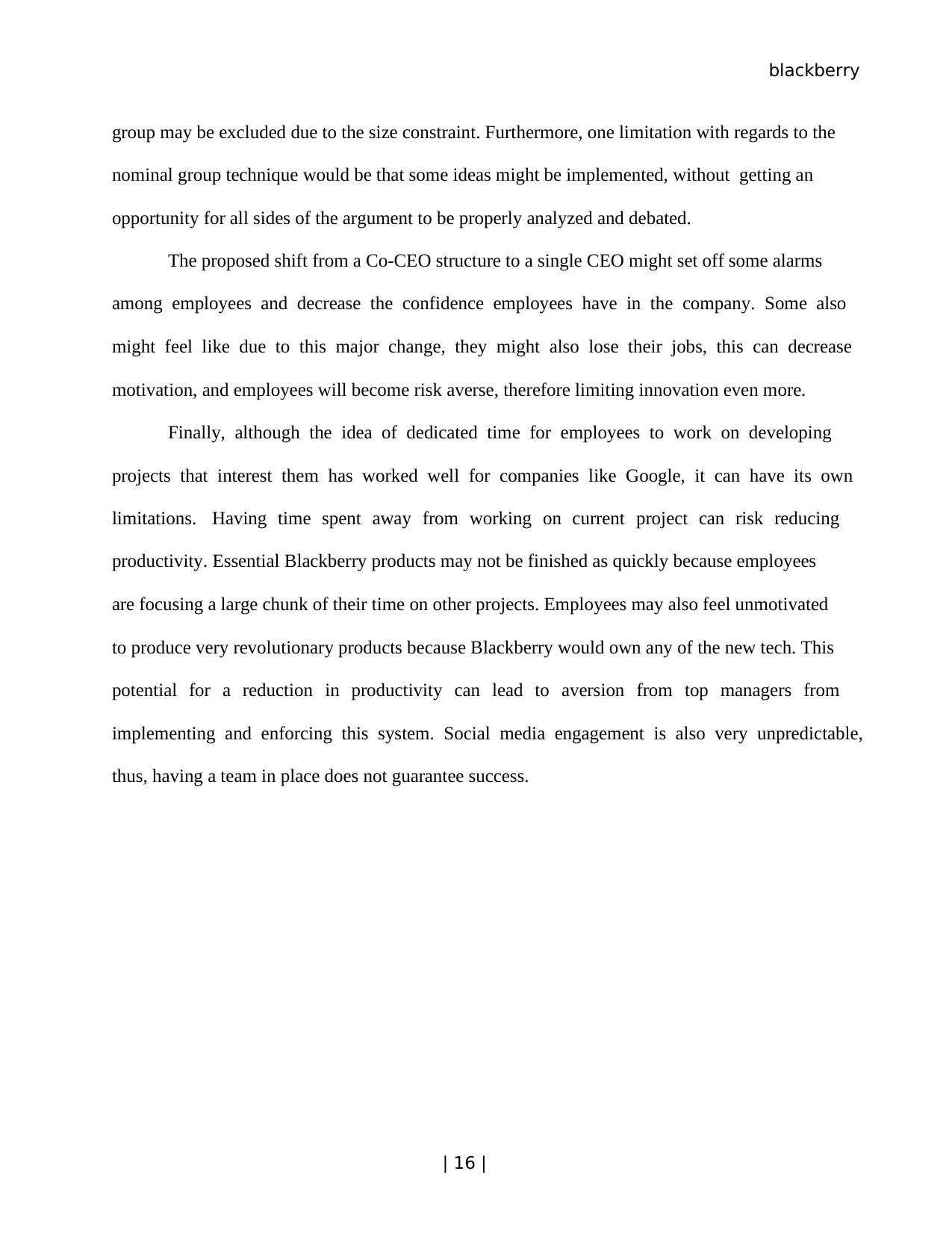
blackberry
| 16 |
group may be excluded due to the size constraint. Furthermore, one limitation with regards to the
nominal group technique would be that some ideas might be implemented, without getting an
opportunity for all sides of the argument to be properly analyzed and debated.
The proposed shift from a Co-CEO structure to a single CEO might set off some alarms
among employees and decrease the confidence employees have in the company. Some also
might feel like due to this major change, they might also lose their jobs, this can decrease
motivation, and employees will become risk averse, therefore limiting innovation even more.
Finally, although the idea of dedicated time for employees to work on developing
projects that interest them has worked well for companies like Google, it can have its own
limitations. Having time spent away from working on current project can risk reducing
productivity. Essential Blackberry products may not be finished as quickly because employees
are focusing a large chunk of their time on other projects. Employees may also feel unmotivated
to produce very revolutionary products because Blackberry would own any of the new tech. This
potential for a reduction in productivity can lead to aversion from top managers from
implementing and enforcing this system. Social media engagement is also very unpredictable,
thus, having a team in place does not guarantee success.
| 16 |
group may be excluded due to the size constraint. Furthermore, one limitation with regards to the
nominal group technique would be that some ideas might be implemented, without getting an
opportunity for all sides of the argument to be properly analyzed and debated.
The proposed shift from a Co-CEO structure to a single CEO might set off some alarms
among employees and decrease the confidence employees have in the company. Some also
might feel like due to this major change, they might also lose their jobs, this can decrease
motivation, and employees will become risk averse, therefore limiting innovation even more.
Finally, although the idea of dedicated time for employees to work on developing
projects that interest them has worked well for companies like Google, it can have its own
limitations. Having time spent away from working on current project can risk reducing
productivity. Essential Blackberry products may not be finished as quickly because employees
are focusing a large chunk of their time on other projects. Employees may also feel unmotivated
to produce very revolutionary products because Blackberry would own any of the new tech. This
potential for a reduction in productivity can lead to aversion from top managers from
implementing and enforcing this system. Social media engagement is also very unpredictable,
thus, having a team in place does not guarantee success.
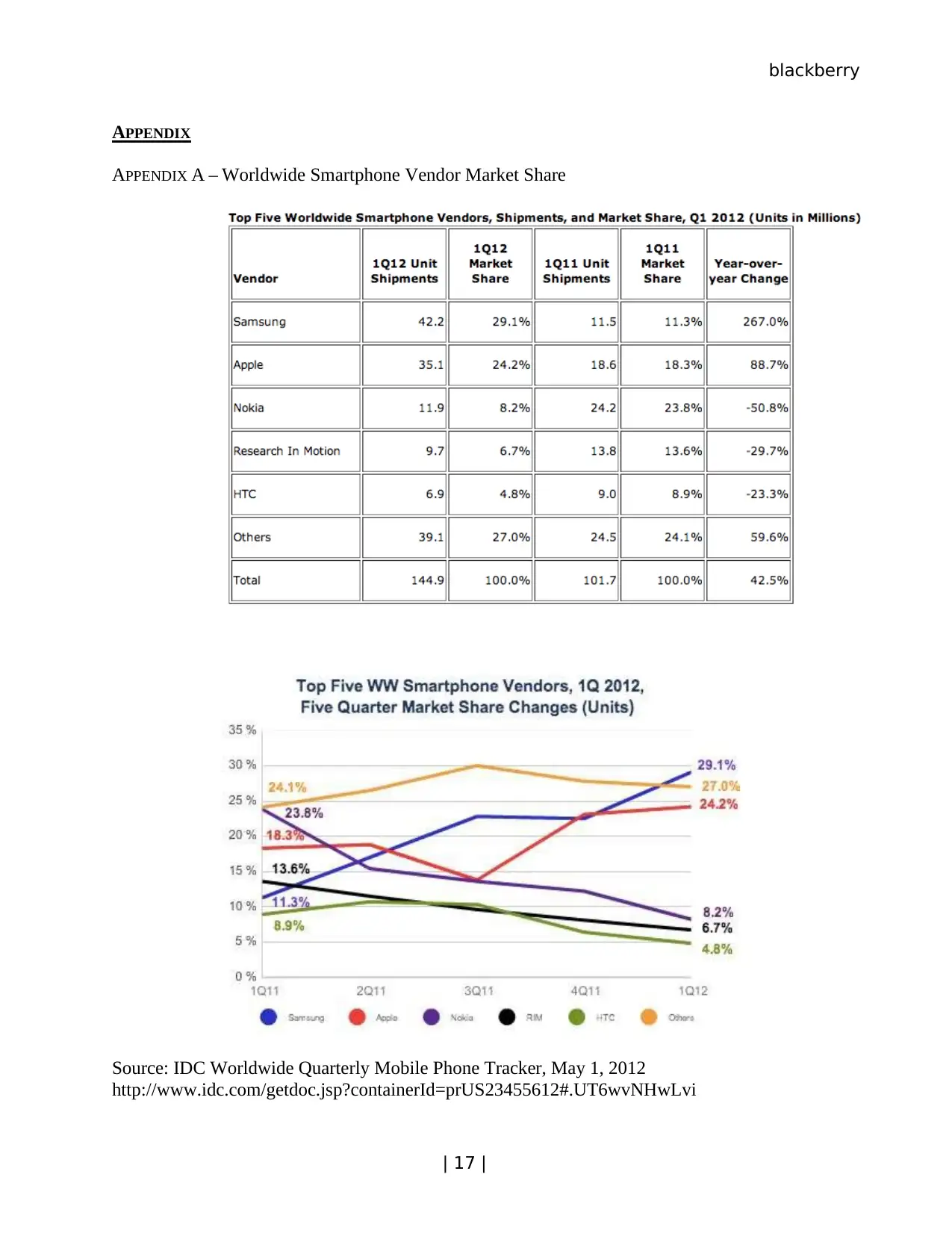
blackberry
| 17 |
APPENDIX
APPENDIX A – Worldwide Smartphone Vendor Market Share
Source: IDC Worldwide Quarterly Mobile Phone Tracker, May 1, 2012
http://www.idc.com/getdoc.jsp?containerId=prUS23455612#.UT6wvNHwLvi
| 17 |
APPENDIX
APPENDIX A – Worldwide Smartphone Vendor Market Share
Source: IDC Worldwide Quarterly Mobile Phone Tracker, May 1, 2012
http://www.idc.com/getdoc.jsp?containerId=prUS23455612#.UT6wvNHwLvi
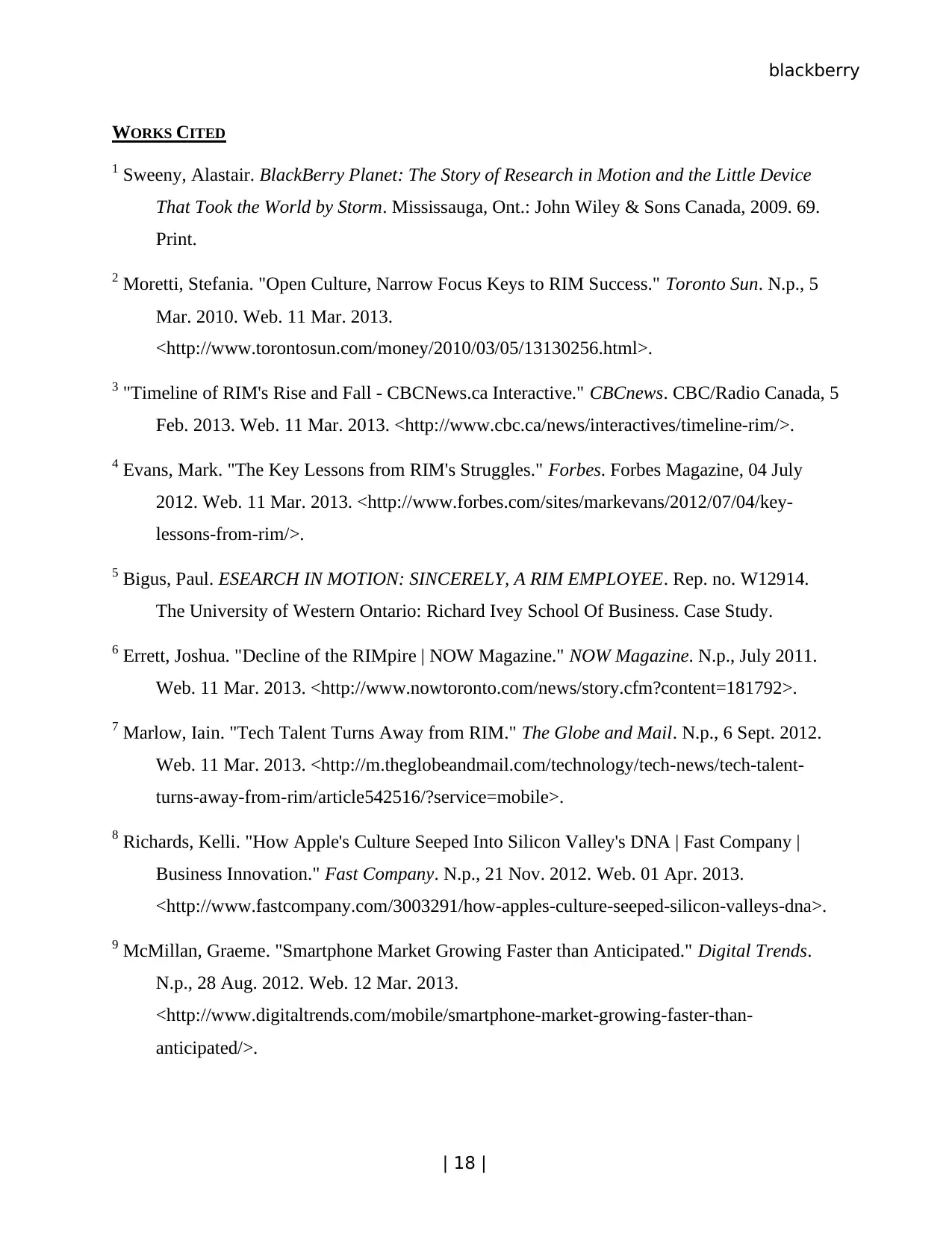
blackberry
| 18 |
WORKS CITED
1 Sweeny, Alastair. BlackBerry Planet: The Story of Research in Motion and the Little Device
That Took the World by Storm. Mississauga, Ont.: John Wiley & Sons Canada, 2009. 69.
Print.
2 Moretti, Stefania. "Open Culture, Narrow Focus Keys to RIM Success." Toronto Sun. N.p., 5
Mar. 2010. Web. 11 Mar. 2013.
<http://www.torontosun.com/money/2010/03/05/13130256.html>.
3 "Timeline of RIM's Rise and Fall - CBCNews.ca Interactive." CBCnews. CBC/Radio Canada, 5
Feb. 2013. Web. 11 Mar. 2013. <http://www.cbc.ca/news/interactives/timeline-rim/>.
4 Evans, Mark. "The Key Lessons from RIM's Struggles." Forbes. Forbes Magazine, 04 July
2012. Web. 11 Mar. 2013. <http://www.forbes.com/sites/markevans/2012/07/04/key-
lessons-from-rim/>.
5 Bigus, Paul. ESEARCH IN MOTION: SINCERELY, A RIM EMPLOYEE. Rep. no. W12914.
The University of Western Ontario: Richard Ivey School Of Business. Case Study.
6 Errett, Joshua. "Decline of the RIMpire | NOW Magazine." NOW Magazine. N.p., July 2011.
Web. 11 Mar. 2013. <http://www.nowtoronto.com/news/story.cfm?content=181792>.
7 Marlow, Iain. "Tech Talent Turns Away from RIM." The Globe and Mail. N.p., 6 Sept. 2012.
Web. 11 Mar. 2013. <http://m.theglobeandmail.com/technology/tech-news/tech-talent-
turns-away-from-rim/article542516/?service=mobile>.
8 Richards, Kelli. "How Apple's Culture Seeped Into Silicon Valley's DNA | Fast Company |
Business Innovation." Fast Company. N.p., 21 Nov. 2012. Web. 01 Apr. 2013.
<http://www.fastcompany.com/3003291/how-apples-culture-seeped-silicon-valleys-dna>.
9 McMillan, Graeme. "Smartphone Market Growing Faster than Anticipated." Digital Trends.
N.p., 28 Aug. 2012. Web. 12 Mar. 2013.
<http://www.digitaltrends.com/mobile/smartphone-market-growing-faster-than-
anticipated/>.
| 18 |
WORKS CITED
1 Sweeny, Alastair. BlackBerry Planet: The Story of Research in Motion and the Little Device
That Took the World by Storm. Mississauga, Ont.: John Wiley & Sons Canada, 2009. 69.
Print.
2 Moretti, Stefania. "Open Culture, Narrow Focus Keys to RIM Success." Toronto Sun. N.p., 5
Mar. 2010. Web. 11 Mar. 2013.
<http://www.torontosun.com/money/2010/03/05/13130256.html>.
3 "Timeline of RIM's Rise and Fall - CBCNews.ca Interactive." CBCnews. CBC/Radio Canada, 5
Feb. 2013. Web. 11 Mar. 2013. <http://www.cbc.ca/news/interactives/timeline-rim/>.
4 Evans, Mark. "The Key Lessons from RIM's Struggles." Forbes. Forbes Magazine, 04 July
2012. Web. 11 Mar. 2013. <http://www.forbes.com/sites/markevans/2012/07/04/key-
lessons-from-rim/>.
5 Bigus, Paul. ESEARCH IN MOTION: SINCERELY, A RIM EMPLOYEE. Rep. no. W12914.
The University of Western Ontario: Richard Ivey School Of Business. Case Study.
6 Errett, Joshua. "Decline of the RIMpire | NOW Magazine." NOW Magazine. N.p., July 2011.
Web. 11 Mar. 2013. <http://www.nowtoronto.com/news/story.cfm?content=181792>.
7 Marlow, Iain. "Tech Talent Turns Away from RIM." The Globe and Mail. N.p., 6 Sept. 2012.
Web. 11 Mar. 2013. <http://m.theglobeandmail.com/technology/tech-news/tech-talent-
turns-away-from-rim/article542516/?service=mobile>.
8 Richards, Kelli. "How Apple's Culture Seeped Into Silicon Valley's DNA | Fast Company |
Business Innovation." Fast Company. N.p., 21 Nov. 2012. Web. 01 Apr. 2013.
<http://www.fastcompany.com/3003291/how-apples-culture-seeped-silicon-valleys-dna>.
9 McMillan, Graeme. "Smartphone Market Growing Faster than Anticipated." Digital Trends.
N.p., 28 Aug. 2012. Web. 12 Mar. 2013.
<http://www.digitaltrends.com/mobile/smartphone-market-growing-faster-than-
anticipated/>.
Paraphrase This Document
Need a fresh take? Get an instant paraphrase of this document with our AI Paraphraser
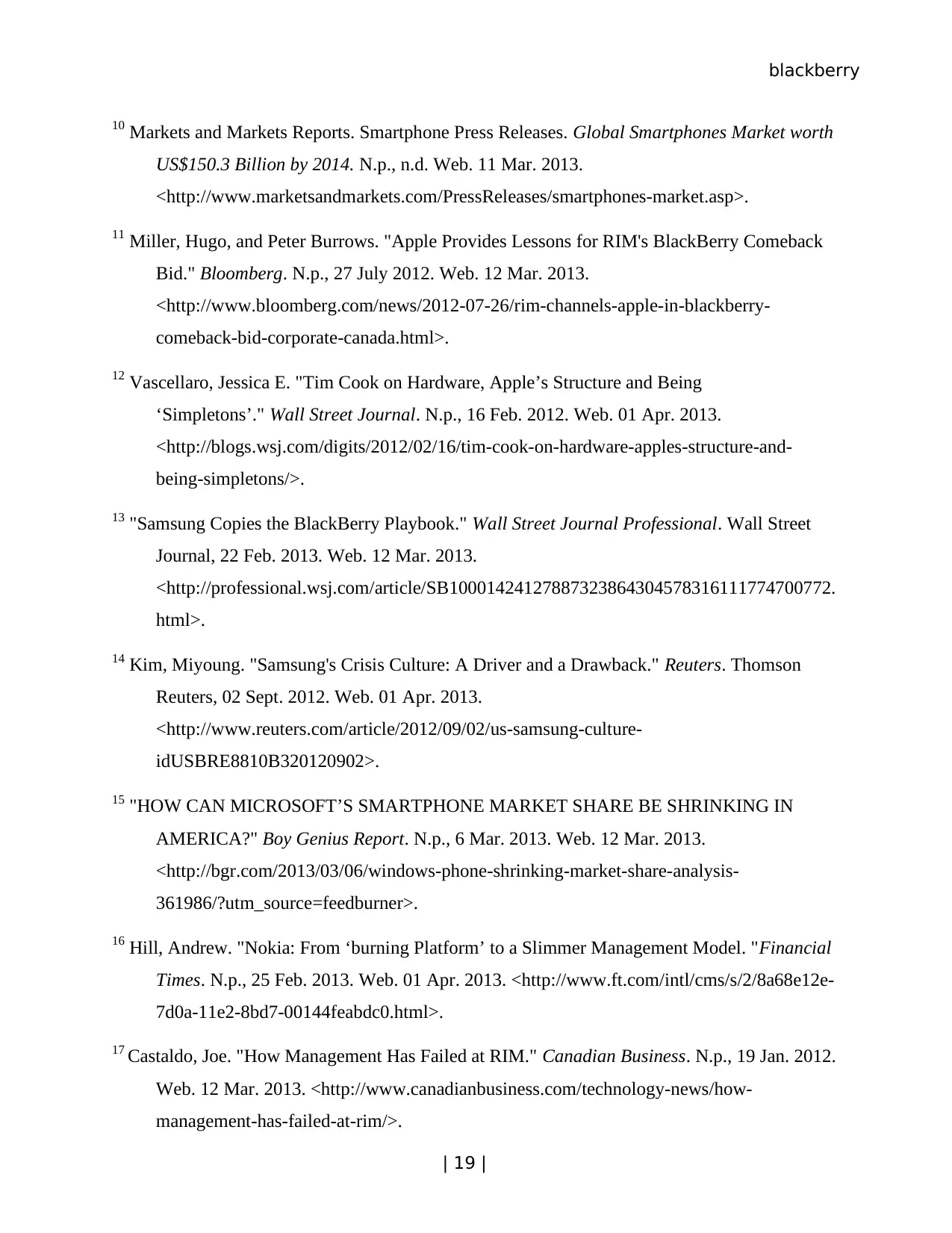
blackberry
| 19 |
10 Markets and Markets Reports. Smartphone Press Releases. Global Smartphones Market worth
US$150.3 Billion by 2014. N.p., n.d. Web. 11 Mar. 2013.
<http://www.marketsandmarkets.com/PressReleases/smartphones-market.asp>.
11 Miller, Hugo, and Peter Burrows. "Apple Provides Lessons for RIM's BlackBerry Comeback
Bid." Bloomberg. N.p., 27 July 2012. Web. 12 Mar. 2013.
<http://www.bloomberg.com/news/2012-07-26/rim-channels-apple-in-blackberry-
comeback-bid-corporate-canada.html>.
12 Vascellaro, Jessica E. "Tim Cook on Hardware, Apple’s Structure and Being
‘Simpletons’." Wall Street Journal. N.p., 16 Feb. 2012. Web. 01 Apr. 2013.
<http://blogs.wsj.com/digits/2012/02/16/tim-cook-on-hardware-apples-structure-and-
being-simpletons/>.
13 "Samsung Copies the BlackBerry Playbook." Wall Street Journal Professional. Wall Street
Journal, 22 Feb. 2013. Web. 12 Mar. 2013.
<http://professional.wsj.com/article/SB10001424127887323864304578316111774700772.
html>.
14 Kim, Miyoung. "Samsung's Crisis Culture: A Driver and a Drawback." Reuters. Thomson
Reuters, 02 Sept. 2012. Web. 01 Apr. 2013.
<http://www.reuters.com/article/2012/09/02/us-samsung-culture-
idUSBRE8810B320120902>.
15 "HOW CAN MICROSOFT’S SMARTPHONE MARKET SHARE BE SHRINKING IN
AMERICA?" Boy Genius Report. N.p., 6 Mar. 2013. Web. 12 Mar. 2013.
<http://bgr.com/2013/03/06/windows-phone-shrinking-market-share-analysis-
361986/?utm_source=feedburner>.
16 Hill, Andrew. "Nokia: From ‘burning Platform’ to a Slimmer Management Model. "Financial
Times. N.p., 25 Feb. 2013. Web. 01 Apr. 2013. <http://www.ft.com/intl/cms/s/2/8a68e12e-
7d0a-11e2-8bd7-00144feabdc0.html>.
17 Castaldo, Joe. "How Management Has Failed at RIM." Canadian Business. N.p., 19 Jan. 2012.
Web. 12 Mar. 2013. <http://www.canadianbusiness.com/technology-news/how-
management-has-failed-at-rim/>.
| 19 |
10 Markets and Markets Reports. Smartphone Press Releases. Global Smartphones Market worth
US$150.3 Billion by 2014. N.p., n.d. Web. 11 Mar. 2013.
<http://www.marketsandmarkets.com/PressReleases/smartphones-market.asp>.
11 Miller, Hugo, and Peter Burrows. "Apple Provides Lessons for RIM's BlackBerry Comeback
Bid." Bloomberg. N.p., 27 July 2012. Web. 12 Mar. 2013.
<http://www.bloomberg.com/news/2012-07-26/rim-channels-apple-in-blackberry-
comeback-bid-corporate-canada.html>.
12 Vascellaro, Jessica E. "Tim Cook on Hardware, Apple’s Structure and Being
‘Simpletons’." Wall Street Journal. N.p., 16 Feb. 2012. Web. 01 Apr. 2013.
<http://blogs.wsj.com/digits/2012/02/16/tim-cook-on-hardware-apples-structure-and-
being-simpletons/>.
13 "Samsung Copies the BlackBerry Playbook." Wall Street Journal Professional. Wall Street
Journal, 22 Feb. 2013. Web. 12 Mar. 2013.
<http://professional.wsj.com/article/SB10001424127887323864304578316111774700772.
html>.
14 Kim, Miyoung. "Samsung's Crisis Culture: A Driver and a Drawback." Reuters. Thomson
Reuters, 02 Sept. 2012. Web. 01 Apr. 2013.
<http://www.reuters.com/article/2012/09/02/us-samsung-culture-
idUSBRE8810B320120902>.
15 "HOW CAN MICROSOFT’S SMARTPHONE MARKET SHARE BE SHRINKING IN
AMERICA?" Boy Genius Report. N.p., 6 Mar. 2013. Web. 12 Mar. 2013.
<http://bgr.com/2013/03/06/windows-phone-shrinking-market-share-analysis-
361986/?utm_source=feedburner>.
16 Hill, Andrew. "Nokia: From ‘burning Platform’ to a Slimmer Management Model. "Financial
Times. N.p., 25 Feb. 2013. Web. 01 Apr. 2013. <http://www.ft.com/intl/cms/s/2/8a68e12e-
7d0a-11e2-8bd7-00144feabdc0.html>.
17 Castaldo, Joe. "How Management Has Failed at RIM." Canadian Business. N.p., 19 Jan. 2012.
Web. 12 Mar. 2013. <http://www.canadianbusiness.com/technology-news/how-
management-has-failed-at-rim/>.
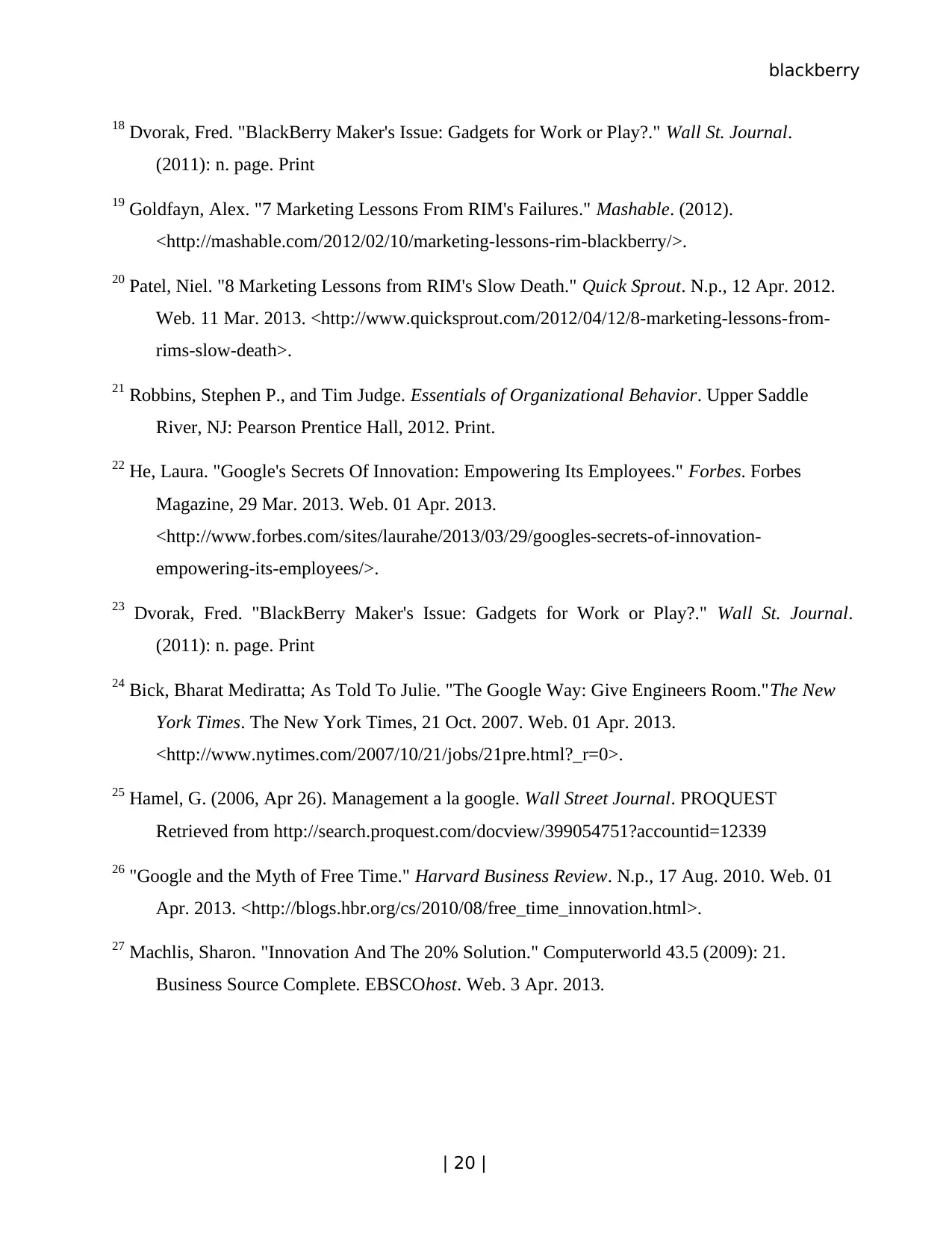
blackberry
| 20 |
18 Dvorak, Fred. "BlackBerry Maker's Issue: Gadgets for Work or Play?." Wall St. Journal.
(2011): n. page. Print
19 Goldfayn, Alex. "7 Marketing Lessons From RIM's Failures." Mashable. (2012).
<http://mashable.com/2012/02/10/marketing-lessons-rim-blackberry/>.
20 Patel, Niel. "8 Marketing Lessons from RIM's Slow Death." Quick Sprout. N.p., 12 Apr. 2012.
Web. 11 Mar. 2013. <http://www.quicksprout.com/2012/04/12/8-marketing-lessons-from-
rims-slow-death>.
21 Robbins, Stephen P., and Tim Judge. Essentials of Organizational Behavior. Upper Saddle
River, NJ: Pearson Prentice Hall, 2012. Print.
22 He, Laura. "Google's Secrets Of Innovation: Empowering Its Employees." Forbes. Forbes
Magazine, 29 Mar. 2013. Web. 01 Apr. 2013.
<http://www.forbes.com/sites/laurahe/2013/03/29/googles-secrets-of-innovation-
empowering-its-employees/>.
23 Dvorak, Fred. "BlackBerry Maker's Issue: Gadgets for Work or Play?." Wall St. Journal.
(2011): n. page. Print
24 Bick, Bharat Mediratta; As Told To Julie. "The Google Way: Give Engineers Room."The New
York Times. The New York Times, 21 Oct. 2007. Web. 01 Apr. 2013.
<http://www.nytimes.com/2007/10/21/jobs/21pre.html?_r=0>.
25 Hamel, G. (2006, Apr 26). Management a la google. Wall Street Journal. PROQUEST
Retrieved from http://search.proquest.com/docview/399054751?accountid=12339
26 "Google and the Myth of Free Time." Harvard Business Review. N.p., 17 Aug. 2010. Web. 01
Apr. 2013. <http://blogs.hbr.org/cs/2010/08/free_time_innovation.html>.
27 Machlis, Sharon. "Innovation And The 20% Solution." Computerworld 43.5 (2009): 21.
Business Source Complete. EBSCOhost. Web. 3 Apr. 2013.
| 20 |
18 Dvorak, Fred. "BlackBerry Maker's Issue: Gadgets for Work or Play?." Wall St. Journal.
(2011): n. page. Print
19 Goldfayn, Alex. "7 Marketing Lessons From RIM's Failures." Mashable. (2012).
<http://mashable.com/2012/02/10/marketing-lessons-rim-blackberry/>.
20 Patel, Niel. "8 Marketing Lessons from RIM's Slow Death." Quick Sprout. N.p., 12 Apr. 2012.
Web. 11 Mar. 2013. <http://www.quicksprout.com/2012/04/12/8-marketing-lessons-from-
rims-slow-death>.
21 Robbins, Stephen P., and Tim Judge. Essentials of Organizational Behavior. Upper Saddle
River, NJ: Pearson Prentice Hall, 2012. Print.
22 He, Laura. "Google's Secrets Of Innovation: Empowering Its Employees." Forbes. Forbes
Magazine, 29 Mar. 2013. Web. 01 Apr. 2013.
<http://www.forbes.com/sites/laurahe/2013/03/29/googles-secrets-of-innovation-
empowering-its-employees/>.
23 Dvorak, Fred. "BlackBerry Maker's Issue: Gadgets for Work or Play?." Wall St. Journal.
(2011): n. page. Print
24 Bick, Bharat Mediratta; As Told To Julie. "The Google Way: Give Engineers Room."The New
York Times. The New York Times, 21 Oct. 2007. Web. 01 Apr. 2013.
<http://www.nytimes.com/2007/10/21/jobs/21pre.html?_r=0>.
25 Hamel, G. (2006, Apr 26). Management a la google. Wall Street Journal. PROQUEST
Retrieved from http://search.proquest.com/docview/399054751?accountid=12339
26 "Google and the Myth of Free Time." Harvard Business Review. N.p., 17 Aug. 2010. Web. 01
Apr. 2013. <http://blogs.hbr.org/cs/2010/08/free_time_innovation.html>.
27 Machlis, Sharon. "Innovation And The 20% Solution." Computerworld 43.5 (2009): 21.
Business Source Complete. EBSCOhost. Web. 3 Apr. 2013.
1 out of 21
Related Documents
Your All-in-One AI-Powered Toolkit for Academic Success.
+13062052269
info@desklib.com
Available 24*7 on WhatsApp / Email
![[object Object]](/_next/static/media/star-bottom.7253800d.svg)
Unlock your academic potential
© 2024 | Zucol Services PVT LTD | All rights reserved.





